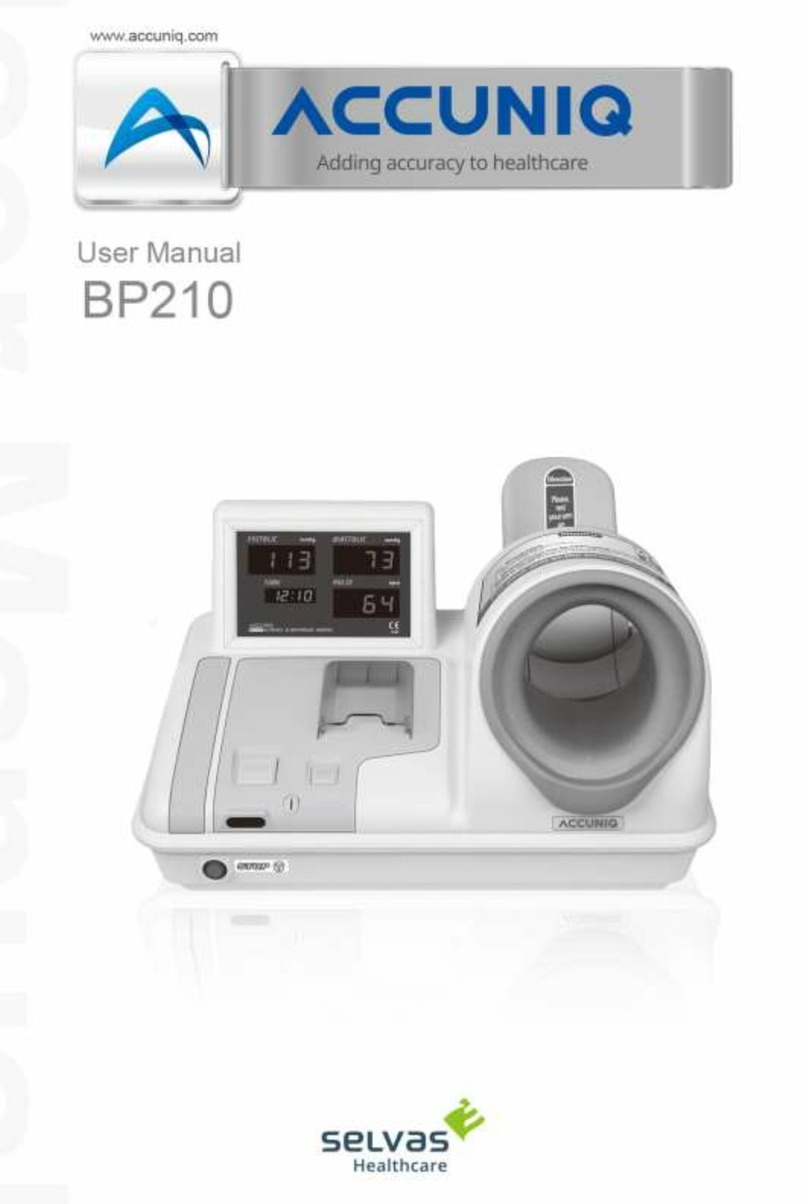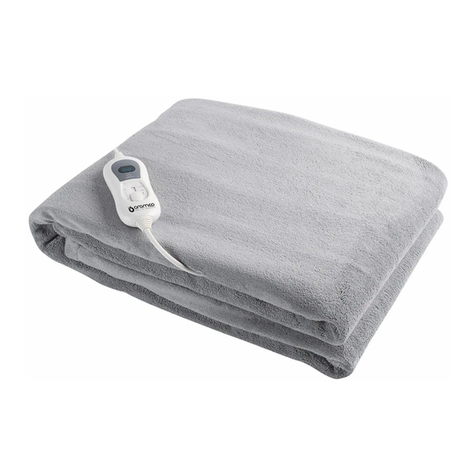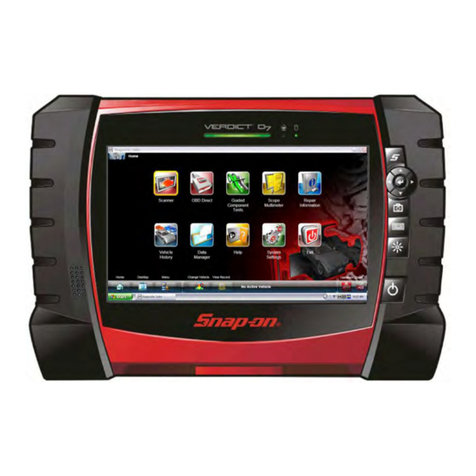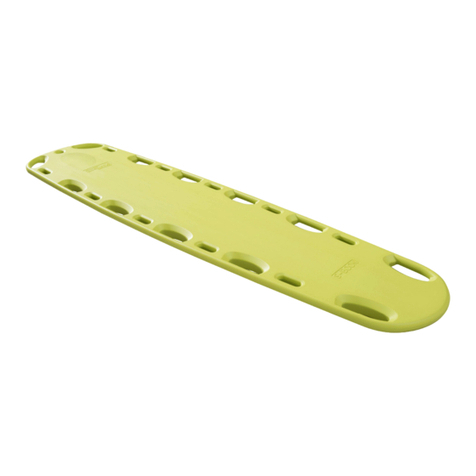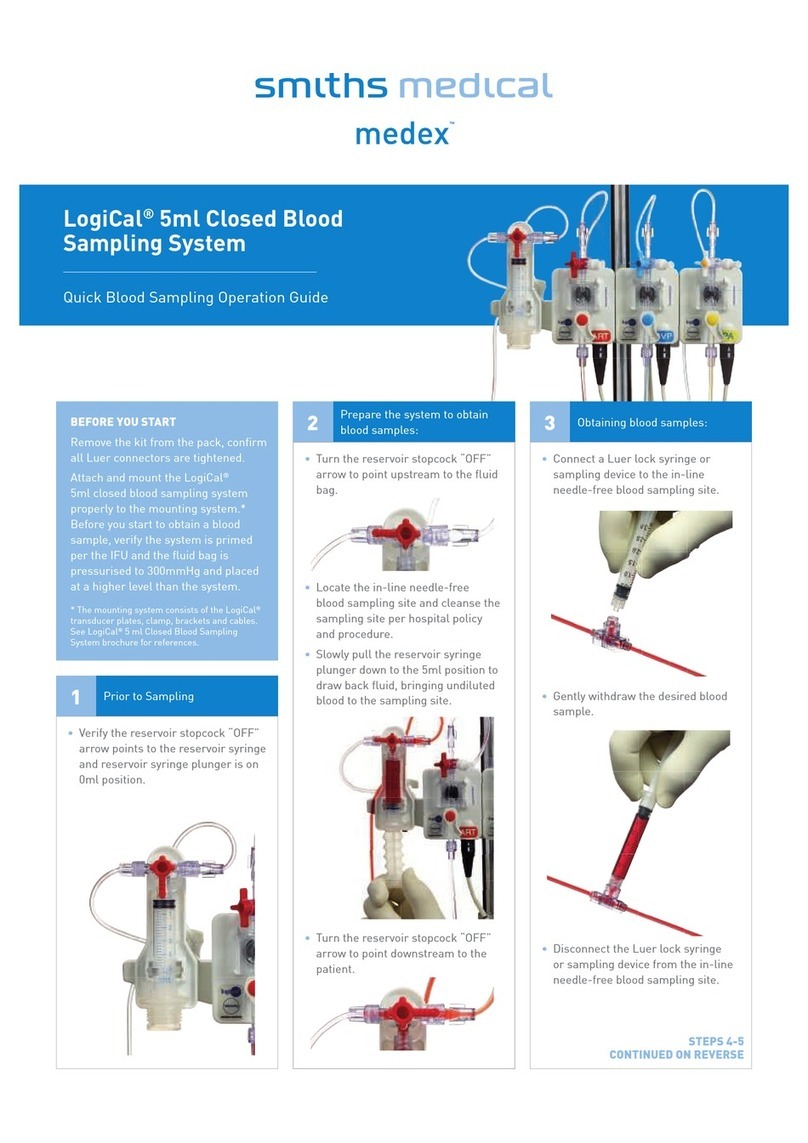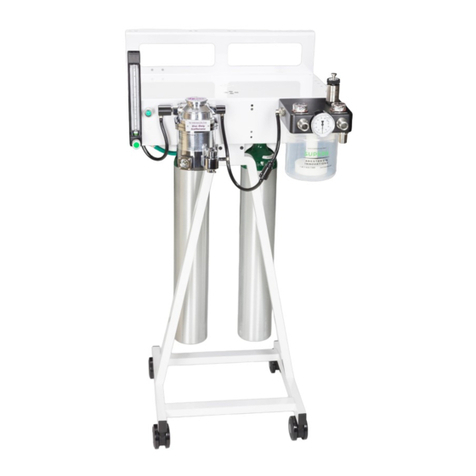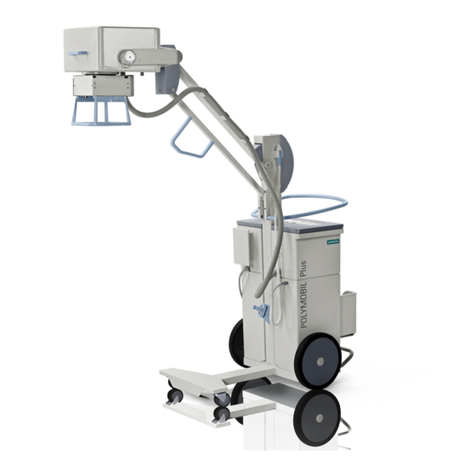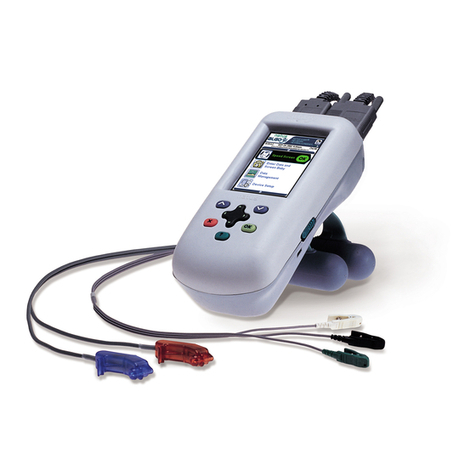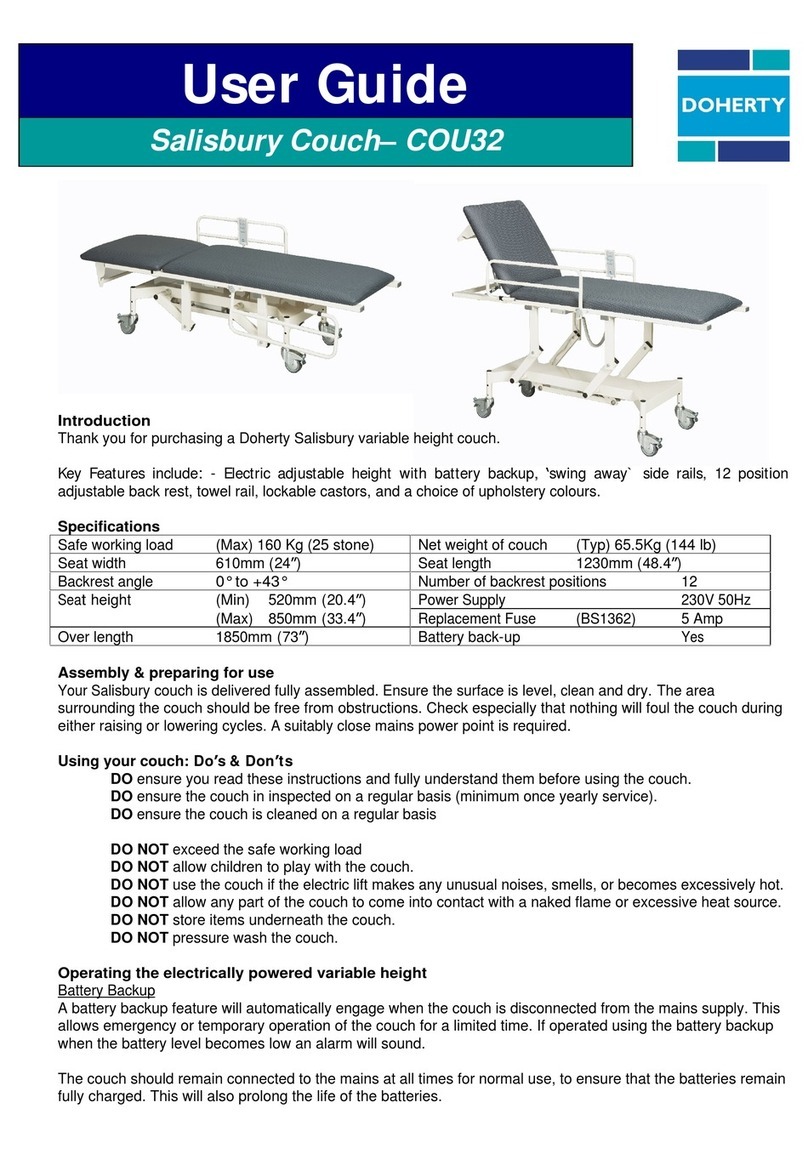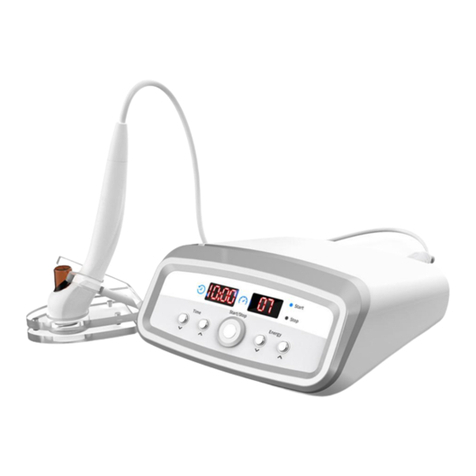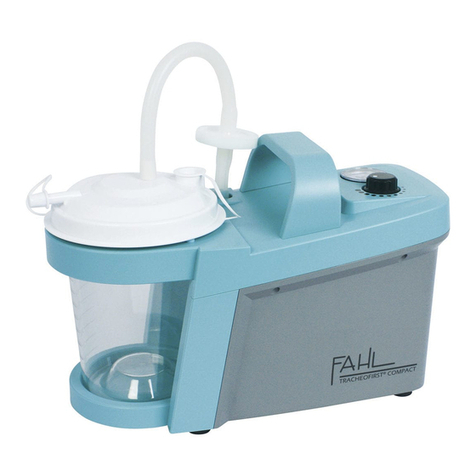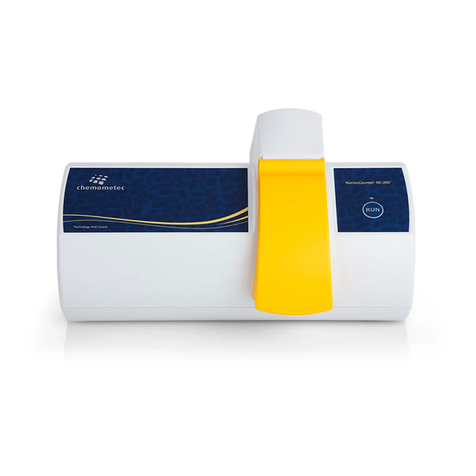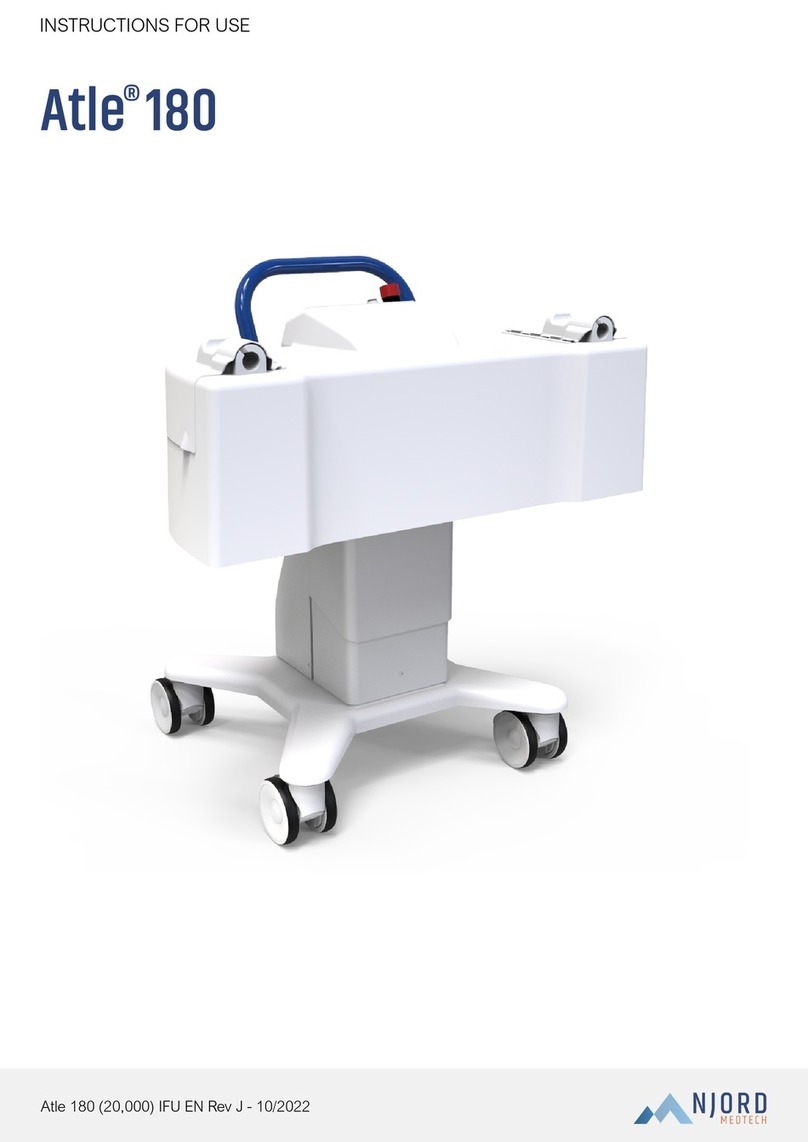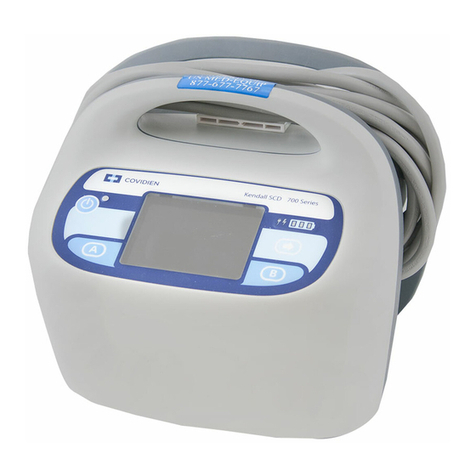CME Medical T34 User manual

Operation Manual
CME Medical T34 Operations Manual Rev 1.4

2 CME Medical T34 Operations Manual Rev 1.4
3
CME Medical T34 Operation Manual Rev 1.4
SECTION 1 INTRODUCTION
1.1 PUMP OVERVIEW
The T34 is a small, lightweight, robust, battery powered infusion pump. The size and weight of the T34
makes it ideal for ambulatory use in a hospital or alternate site / homecare setting. It is equally suitable for
adults or paediatric use. Safety features include access code protected areas, keypad lock and event log.
The T34 syringe pump may be used to deliver indicated medications via any common infusion routes in-
cluding intravenous and subcutaneous.
The T34 offers 3 point syringe detection enabling the pump to identify all commonly used (or pro-
grammed) syringe brands. This feature also enables the pump to calculate the syringe volume and, de-
pending on the mode of operation, deliver the contents over a specified duration or as mls per hour infu-
sion therefore minimising the risk of programming errors. The sensors also activate an alarm if the syringe
is removed or partially displaced during infusion.
1.2 MODES OF OPERATION
The pump can be configured (and locked) to one of three modes of operation, the default mode of opera-
tion is Lock on.
The mode of operation options are:
Lock on is delivering the contents of a syringe over a fixed duration (pump default 24 hours). The pump
automatically calculates the ml/hour rate based on the fixed duration (lock on) and the confirmed deliver-
able volume.
Lock off is delivering the contents of a syringe over the default duration or a duration inputted by the user.
The pump automatically calculates the ml/hour rate based on the confirmed duration and the confirmed
deliverable volume.
Rate mode is delivering the contents of a syringe by ml/hr as inputted by the user. The pump calculates
the duration from the entered ml/hour rate and the syringe volume detected by the pump.
1.3 INTENDED USE
The T34 syringe pump is designed for infusion of medications or fluids requiring continuous or intermittent
delivery at precisely controlled infusion rates through all clinically acceptable routes of administration in-
cluding intravenous, subcutaneous, percutaneous, epidural in close proximity to nerves, and into an intra-
operative site (soft tissue/body cavity/surgical wound site). The system is intended for patients who re-
quire maintenance medications, analgesics, chemotherapeutic agents and general fluids therapy in hospi-
tal and homecare environments.
1.4 CONTRAINDICATIONS
Infusion of blood and blood products where appropriate, consult with pump manufacturer.
Infusion of insulin.
Infusion of critical medications whose stoppage or interruption could cause serious injury or death.
Use in ambulatory regimens by patients who do not possess the mental, physical or emotional capabil-
ity to self-administer their therapy; or who are not under the care of a responsible individual.
2
2
CME Medical T34 Operation Manual Rev 1.4
Section 1 INTRODUCTION 3-8
1.1 Pump Overview ............................................................................................................. 3
1.2 Modes Of Operation ...................................................................................................... 3
1.3 Intended Use ................................................................................................................. 3
1.4 Contraindications ........................................................................................................... 3
1.5 About This Manual ......................................................................................................... 4
1.6 Warnings And Notes ...................................................................................................... 4
1.7 Operating Precautions ................................................................................................... 4-5
1.8 System Symbols ............................................................................................................. 6
1.9 Pump Inspection And Unpacking ................................................................................... 7
1.10 Lockbox .......................................................................................................................... 7
1.11 Carry Pouches ................................................................................................................ 7
1.12 BodyComm Communications Software ......................................................................... 8
1.13 Disposable and Rechargeable Batteries ........................................................................ 8
Section 2 FEATURES AND FUNCTIONS 9-21
2.1 Pump Feature Recognition ............................................................................................... 9
2.2 Access Codes .................................................................................................................... 10
2.3 Keypad Lock ..................................................................................................................... 10
2.4 Event Log .......................................................................................................................... 11
2.5 Post Occlusion Bolus ........................................................................................................ 11
2.6 Syringe Brands And Sizes ................................................................................................. 12
2.7 Administration Sets .......................................................................................................... 12-13
2.8 Battery Fitting .................................................................................................................. 14
2.9 Battery Life ....................................................................................................................... 14
2.10 Powering On, Pump Paused/Stopped and Powering Off ................................................. 14
2.11 Pump Info Menu .............................................................................................................. 15
2.12 Pump And BodyComm Configuration .............................................................................. 15
2.13 Pre-Loading, Programme Protection And “Resume/New Syringe ................................... 16-17
2.14 Syringe Loading, Detection And Confirmation ................................................................. 18
2.15 Lock ON, Lock OFF And Rate Modes Of Operation .......................................................... 19
2.16 Rate Change (Titration) during Infusion ........................................................................... 19
2.17 Recommended Safety Checks During Infusion ................................................................ 20
2.18 Alerts, Alarms And Troubleshooting ................................................................................ 20-21
2.19 KVO (keep vein open) ....................................................................................................... 22
2.20 Purge function .................................................................................................................. 22
Section 3 MAINTENANCE, CLEANING AND SERVICE 23-24
3.1 Pump Cleaning ................................................................................................................. 23
3.2 Lockbox Cleaning .............................................................................................................. 23
3.3 Re-Usable Pouch Cleaning ............................................................................................... 23
3.4 Pump Storage ................................................................................................................... 23
3.5 Servicing ........................................................................................................................... 24
3.6 Disposal/Decommissioning .............................................................................................. 24
Section 4 USER GUIDES 24-34
4.1-4.10 User Guides ....................................................................................................................... 25-34
Section 5 APPENDICES 35-36
5.1 T34 Syringe Pump Specifications ..................................................................................... 35
5.2 Limited Warranty ............................................................................................................. 36
5.3 Contact Details ................................................................................................................. 37
5.4 Index ................................................................................................................................ 38

CME Medical T34 Operations Manual Rev 1.4 3
3
CME Medical T34 Operation Manual Rev 1.4
SECTION 1 INTRODUCTION
1.1 PUMP OVERVIEW
The T34 is a small, lightweight, robust, battery powered infusion pump. The size and weight of the T34
makes it ideal for ambulatory use in a hospital or alternate site / homecare setting. It is equally suitable for
adults or paediatric use. Safety features include access code protected areas, keypad lock and event log.
The T34 syringe pump may be used to deliver indicated medications via any common infusion routes in-
cluding intravenous and subcutaneous.
The T34 offers 3 point syringe detection enabling the pump to identify all commonly used (or pro-
grammed) syringe brands. This feature also enables the pump to calculate the syringe volume and, de-
pending on the mode of operation, deliver the contents over a specified duration or as mls per hour infu-
sion therefore minimising the risk of programming errors. The sensors also activate an alarm if the syringe
is removed or partially displaced during infusion.
1.2 MODES OF OPERATION
The pump can be configured (and locked) to one of three modes of operation, the default mode of opera-
tion is Lock on.
The mode of operation options are:
Lock on is delivering the contents of a syringe over a fixed duration (pump default 24 hours). The pump
automatically calculates the ml/hour rate based on the fixed duration (lock on) and the confirmed deliver-
able volume.
Lock off is delivering the contents of a syringe over the default duration or a duration inputted by the user.
The pump automatically calculates the ml/hour rate based on the confirmed duration and the confirmed
deliverable volume.
Rate mode is delivering the contents of a syringe by ml/hr as inputted by the user. The pump calculates
the duration from the entered ml/hour rate and the syringe volume detected by the pump.
1.3 INTENDED USE
The T34 syringe pump is designed for infusion of medications or fluids requiring continuous or intermittent
delivery at precisely controlled infusion rates through all clinically acceptable routes of administration in-
cluding intravenous, subcutaneous, percutaneous, epidural in close proximity to nerves, and into an intra-
operative site (soft tissue/body cavity/surgical wound site). The system is intended for patients who re-
quire maintenance medications, analgesics, chemotherapeutic agents and general fluids therapy in hospi-
tal and homecare environments.
1.4 CONTRAINDICATIONS
Infusion of blood and blood products where appropriate, consult with pump manufacturer.
Infusion of insulin.
Infusion of critical medications whose stoppage or interruption could cause serious injury or death.
Use in ambulatory regimens by patients who do not possess the mental, physical or emotional capabil-
ity to self-administer their therapy; or who are not under the care of a responsible individual.
2
CME Medical T34 Operation Manual Rev 1.4
Section 1 INTRODUCTION 3-8
1.1 Pump Overview ............................................................................................................. 3
1.2 Modes Of Operation ...................................................................................................... 3
1.3 Intended Use ................................................................................................................. 3
1.4 Contraindications ........................................................................................................... 3
1.5 About This Manual ......................................................................................................... 4
1.6 Warnings And Notes ...................................................................................................... 4
1.7 Operating Precautions ................................................................................................... 4-5
1.8 System Symbols ............................................................................................................. 6
1.9 Pump Inspection And Unpacking ................................................................................... 7
1.10 Lockbox .......................................................................................................................... 7
1.11 Carry Pouches ................................................................................................................ 7
1.12 BodyComm Communications Software ......................................................................... 8
1.13 Disposable and Rechargeable Batteries ........................................................................ 8
Section 2 FEATURES AND FUNCTIONS 9-21
2.1 Pump Feature Recognition ............................................................................................... 9
2.2 Access Codes .................................................................................................................... 10
2.3 Keypad Lock ..................................................................................................................... 10
2.4 Event Log .......................................................................................................................... 11
2.5 Post Occlusion Bolus ........................................................................................................ 11
2.6 Syringe Brands And Sizes ................................................................................................. 12
2.7 Administration Sets .......................................................................................................... 12-13
2.8 Battery Fitting .................................................................................................................. 14
2.9 Battery Life ....................................................................................................................... 14
2.10 Powering On, Pump Paused/Stopped and Powering Off ................................................. 14
2.11 Pump Info Menu .............................................................................................................. 15
2.12 Pump And BodyComm Configuration .............................................................................. 15
2.13 Pre-Loading, Programme Protection And “Resume/New Syringe ................................... 16-17
2.14 Syringe Loading, Detection And Confirmation ................................................................. 18
2.15 Lock ON, Lock OFF And Rate Modes Of Operation .......................................................... 19
2.16 Rate Change (Titration) during Infusion ........................................................................... 19
2.17 Recommended Safety Checks During Infusion ................................................................ 20
2.18 Alerts, Alarms And Troubleshooting ................................................................................ 20-21
2.19 KVO (keep vein open) ....................................................................................................... 22
2.20 Purge function .................................................................................................................. 22
Section 3 MAINTENANCE, CLEANING AND SERVICE 23-24
3.1 Pump Cleaning ................................................................................................................. 23
3.2 Lockbox Cleaning .............................................................................................................. 23
3.3 Re-Usable Pouch Cleaning ............................................................................................... 23
3.4 Pump Storage ................................................................................................................... 23
3.5 Servicing ........................................................................................................................... 24
3.6 Disposal/Decommissioning .............................................................................................. 24
Section 4 USER GUIDES 24-34
4.1-4.10 User Guides ....................................................................................................................... 25-34
Section 5 APPENDICES 35-36
5.1 T34 Syringe Pump Specifications ..................................................................................... 35
5.2 Limited Warranty ............................................................................................................. 36
5.3 Contact Details ................................................................................................................. 37
5.4 Index ................................................................................................................................ 38

4 CME Medical T34 Operations Manual Rev 1.4
1.5 ABOUT THIS MANUAL
The operator must be thoroughly familiar with the T34 syringe pump described in this manual prior to
use, and in particular must read and understand any warnings and precautions stated herein. If a soft-
ware change occurs and the operation/specification for the pump changes, new or additional operat-
ing instructions will be issued, if needed.
All illustrations used in this manual show typical settings and values that may be used in setting up the
functions of the pump. These settings and values are for illustrative use only. The complete range of
settings and values are listed in the specifications section of this manual.
This operation manual document has been developed with consideration to the requirements in rele-
vant Harmonised Standards. Data presented in the technical specifications reflect specific test condi-
tions defined in this standard. Other external factors such as varying back pressure, temperature,
head height, set usage, fluid restrictions, solution viscosity or combinations of these factors, may re-
sult in deviations from the performance data enclosed.
1.6 WARNINGS AND NOTES
Warnings and notes will be seen throughout this manual. These are described as:
NOTE: Indicate that the information that follows is additional important information, a tip that will help
you recover from an error or point you to related information within the manual.
WARNING: Warnings advise of circumstances that could result in injury or death to the user/operator or
circumstances that could result in damage to the device. Read and understand this manual and all warn-
ings before operating the T34 syringe pump.
1.7 OPERATING PRECAUTIONS
This device complies with Part 15 of the FCC Rules. Operation is subject to the following two condi-
tions: (1)this device may not cause harmful interference (2) this device must accept any interference
received, including interference that may cause undesired operation.
Although the T34 syringe pump has been designed and manufactured to exact specifications, it is not
intended to replace trained personnel in the supervision of infusions.
CME Medical will assume no responsibility for incidents which may occur if the product is not used,
stored or transported in accordance with the environmental conditions stipulated in this document and
on the package labelling.
This syringe pump is designed for ambulatory use and should withstand everyday handling. If the pump
is dropped onto a hard surface, or is suspected of being dropped, the operation and calibration should
be checked by a qualified technician.
The specified accuracy of the pump can only be maintained if the pump is used, maintained and ser-
viced in accordance with the instructions given in this manual. If the pump has failed to calibrate during
the servicing procedure, it must be returned for repair or disposal.
Adjustments, maintenance, or repair made by un-certified service personnel may impair the operation
of the pump and/or the accuracy of the infusion. Make sure any adjustments, maintenance, or repair
of the device are carried out only by authorised and skilled technicians.
Refer all service, repair and adjustments only to qualified and certified technical personnel. Unauthor-
ised modifications or the use of any spare parts, other than those supplied by the manufacturer or
their distributor, will void any warranty.
5
CME Medical T34 Operation Manual Rev 1.4
If the pump is dropped, subjected to excessive moisture, humidity or high temperature, or otherwise
suspected to have been damaged, remove it from service for inspection by qualified personnel.
The pump has been designed to be as safe as possible to handle; however, care should be exercised to
avoid trapping of fingers or other body parts in the mechanism.
The T34 syringe pump system should be operated within a temperature range of 15°C (59°F) to 45°C
(113°F). Operation at temperatures outside this range may affect accuracy.
INFUSION PRECAUTIONS
Carefully read and follow accompanying set instructions for priming the set and the recommended set
change interval.
The syringe and administration set should be disposed of in an appropriate manner, considering the
nature of the residual fluid that may be contained within and in accordance with the hospital/
homecare provider’s disposal practices.
Drugs for infusion to be used with the pump may only be prescribed by a qualified medical
practitioner. Caution must be exercised in the selection of drugs and the amount and rate intended to
be delivered via any infusion pump.
If the drug contained in the syringe will be exposed to extreme environmental conditions for prolonged
time periods, it is important to select drugs that will not change pharmacologically upon such
exposure.
As with all automatic infusion devices, whenever a toxic or dangerous level of drug is stored in the
reservoir, constant/frequent monitoring of the infusion is required.
In all applications, time to alarm under occlusion or other fault conditions will depend on the infusion
rate and levels of alarm settings. It is recommended to consider these parameters when using drugs
requiring infusion stability or low flow rates and therefore a quick time to alarm.
GENERAL PRECAUTIONS
Do not use hard or sharp objects on the keypad.
Do not bathe or shower whilst using the pump. The pump is resistant to a limited amount of splashing,
but its construction does not make it resistant to large amounts of spraying or immersion in liquids.
Damage to the internal components may result.
If the pump is dropped, subjected to excessive moisture, humidity or high temperature, or otherwise
suspected to have been damaged, remove it from service for inspection by qualified personnel.
Do not operate the pump near high-energy radio-frequency emitting equipment, such as
electro-surgical cauterising equipment as this may result in false alarm signals or error messages being
displayed.

CME Medical T34 Operations Manual Rev 1.4 5
1.5 ABOUT THIS MANUAL
The operator must be thoroughly familiar with the T34 syringe pump described in this manual prior to
use, and in particular must read and understand any warnings and precautions stated herein. If a soft-
ware change occurs and the operation/specification for the pump changes, new or additional operat-
ing instructions will be issued, if needed.
All illustrations used in this manual show typical settings and values that may be used in setting up the
functions of the pump. These settings and values are for illustrative use only. The complete range of
settings and values are listed in the specifications section of this manual.
This operation manual document has been developed with consideration to the requirements in rele-
vant Harmonised Standards. Data presented in the technical specifications reflect specific test condi-
tions defined in this standard. Other external factors such as varying back pressure, temperature,
head height, set usage, fluid restrictions, solution viscosity or combinations of these factors, may re-
sult in deviations from the performance data enclosed.
1.6 WARNINGS AND NOTES
Warnings and notes will be seen throughout this manual. These are described as:
NOTE: Indicate that the information that follows is additional important information, a tip that will help
you recover from an error or point you to related information within the manual.
WARNING: Warnings advise of circumstances that could result in injury or death to the user/operator or
circumstances that could result in damage to the device. Read and understand this manual and all warn-
ings before operating the T34 syringe pump.
1.7 OPERATING PRECAUTIONS
This device complies with Part 15 of the FCC Rules. Operation is subject to the following two condi-
tions: (1)this device may not cause harmful interference (2) this device must accept any interference
received, including interference that may cause undesired operation.
Although the T34 syringe pump has been designed and manufactured to exact specifications, it is not
intended to replace trained personnel in the supervision of infusions.
CME Medical will assume no responsibility for incidents which may occur if the product is not used,
stored or transported in accordance with the environmental conditions stipulated in this document and
on the package labelling.
This syringe pump is designed for ambulatory use and should withstand everyday handling. If the pump
is dropped onto a hard surface, or is suspected of being dropped, the operation and calibration should
be checked by a qualified technician.
The specified accuracy of the pump can only be maintained if the pump is used, maintained and ser-
viced in accordance with the instructions given in this manual. If the pump has failed to calibrate during
the servicing procedure, it must be returned for repair or disposal.
Adjustments, maintenance, or repair made by un-certified service personnel may impair the operation
of the pump and/or the accuracy of the infusion. Make sure any adjustments, maintenance, or repair
of the device are carried out only by authorised and skilled technicians.
Refer all service, repair and adjustments only to qualified and certified technical personnel. Unauthor-
ised modifications or the use of any spare parts, other than those supplied by the manufacturer or
their distributor, will void any warranty.
5
CME Medical T34 Operation Manual Rev 1.4
If the pump is dropped, subjected to excessive moisture, humidity or high temperature, or otherwise
suspected to have been damaged, remove it from service for inspection by qualified personnel.
The pump has been designed to be as safe as possible to handle; however, care should be exercised to
avoid trapping of fingers or other body parts in the mechanism.
The T34 syringe pump system should be operated within a temperature range of 15°C (59°F) to 45°C
(113°F). Operation at temperatures outside this range may affect accuracy.
INFUSION PRECAUTIONS
Carefully read and follow accompanying set instructions for priming the set and the recommended set
change interval.
The syringe and administration set should be disposed of in an appropriate manner, considering the
nature of the residual fluid that may be contained within and in accordance with the hospital/
homecare provider’s disposal practices.
Drugs for infusion to be used with the pump may only be prescribed by a qualified medical
practitioner. Caution must be exercised in the selection of drugs and the amount and rate intended to
be delivered via any infusion pump.
If the drug contained in the syringe will be exposed to extreme environmental conditions for prolonged
time periods, it is important to select drugs that will not change pharmacologically upon such
exposure.
As with all automatic infusion devices, whenever a toxic or dangerous level of drug is stored in the
reservoir, constant/frequent monitoring of the infusion is required.
In all applications, time to alarm under occlusion or other fault conditions will depend on the infusion
rate and levels of alarm settings. It is recommended to consider these parameters when using drugs
requiring infusion stability or low flow rates and therefore a quick time to alarm.
GENERAL PRECAUTIONS
Do not use hard or sharp objects on the keypad.
Do not bathe or shower whilst using the pump. The pump is resistant to a limited amount of splashing,
but its construction does not make it resistant to large amounts of spraying or immersion in liquids.
Damage to the internal components may result.
If the pump is dropped, subjected to excessive moisture, humidity or high temperature, or otherwise
suspected to have been damaged, remove it from service for inspection by qualified personnel.
Do not operate the pump near high-energy radio-frequency emitting equipment, such as
electro-surgical cauterising equipment as this may result in false alarm signals or error messages being
displayed.

6 CME Medical T34 Operations Manual Rev 1.4
6
CME Medical T34 Operation Manual Rev 1.4
1.8 SYSTEM SYMBOLS
The following symbols are used on the T34 syringe pump and components. Labels on the pump or state-
ments in this manual preceded by any of the following words and/or symbols are of special significance
and/or are intended to help you to operate the pump in a safe and successful manner.
SYMBOL DESCRIPTION
Type of protection against electric shock—Class 11 equipment
Attention, consult accompanying instructions
CSA mark
0344
CE mark indicates conformance to Medical Device Directive 93/42/EEC
Do not dispose of in municipal waste. Symbol indicates separate collection for
electrical and electronic equipment. (WEEE Directive 2002/96/EEC) NOTE: Does
not apply to the battery.
Do not dispose of battery in municipal waste. Symbol indicates separate collection
for battery is required.
The use of single-use disposable components on more than one patient is a
biological hazard. Do not reuse single-use disposable components.
Type CF applied part
Date of Manufacture
SN Serial Number
Expiry Date (consumables)
LOT Lot Number (consumables)
7
CME Medical T34 Operation Manual Rev 1.4
1.9 PUMP INSPECTION AND UNPACKING
Remove the T34 syringe pump and accessories from the packaging and inspect for damage during
shipment or storage.
Make sure you have the following items:
T34 syringe pump
(the packing box will include information on how to access the operation manual electronically).
Accessories (if purchased):
Alkaline 9V batteries
Lockbox (supplied with two keys)
Carry Pouch
Rechargeable batteries and charger
If any items are missing or damaged, contact your supplies department.
1.10 LOCKBOX
The lockbox will fit most commonly used syringe
brands and sizes up to 30ml.
Lock boxes are made from Polycarbonate due to
its high impact, temperature resistance and optical
properties, durability tests confirm that the overall
design and construction of the T34 lock box
ensures that they are fit for their intended purpose of protecting the T34 syringe driver from damage
caused through normal daily use and drops within the accepted normal range of one meter.
Refer to your local sales representative or CME Medical website for information on types, codes and costs.
1.11 CARRY POUCHES
Disposable and re-useable (washable) pouches are available for optional use.
Refer to your local sales representative or CME Medical website for information on types, codes and costs.
WARNING: Do not use the T34 syringe pump if there are any obvious signs of damage. Return for
inspection by authorised service personnel.
WARNING: Visually inspect packaging and contents before each use. Do not use consumables if the
packaging is in any way damaged as sterility may have been compromised.
NOTE: lockboxes are designed for the use with CME Medical administration sets. If using an alternate
brand of administration set with a commonly used 30ml syringe the set design may prevent the lockbox
from fully closing and locking.
WARNING: Unsafe operation may result from using improper accessories. Only use accessories designed
for the system.
6
CME Medical T34 Operation Manual Rev 1.4
1.8 SYSTEM SYMBOLS
The following symbols are used on the T34 syringe pump and components. Labels on the pump or state-
ments in this manual preceded by any of the following words and/or symbols are of special significance
and/or are intended to help you to operate the pump in a safe and successful manner.
SYMBOL DESCRIPTION
Type of protection against electric shock—Class 11 equipment
Attention, consult accompanying instructions
CSA mark
0344
CE mark indicates conformance to Medical Device Directive 93/42/EEC
Do not dispose of in municipal waste. Symbol indicates separate collection for
electrical and electronic equipment. (WEEE Directive 2002/96/EEC) NOTE: Does
not apply to the battery.
Do not dispose of battery in municipal waste. Symbol indicates separate collection
for battery is required.
The use of single-use disposable components on more than one patient is a
biological hazard. Do not reuse single-use disposable components.
Type CF applied part
Date of Manufacture
SN Serial Number
Expiry Date (consumables)
LOT Lot Number (consumables)
SN
C US

CME Medical T34 Operations Manual Rev 1.4 7
6
CME Medical T34 Operation Manual Rev 1.4
1.8 SYSTEM SYMBOLS
The following symbols are used on the T34 syringe pump and components. Labels on the pump or state-
ments in this manual preceded by any of the following words and/or symbols are of special significance
and/or are intended to help you to operate the pump in a safe and successful manner.
SYMBOL DESCRIPTION
Type of protection against electric shock—Class 11 equipment
Attention, consult accompanying instructions
CSA mark
0344
CE mark indicates conformance to Medical Device Directive 93/42/EEC
Do not dispose of in municipal waste. Symbol indicates separate collection for
electrical and electronic equipment. (WEEE Directive 2002/96/EEC) NOTE: Does
not apply to the battery.
Do not dispose of battery in municipal waste. Symbol indicates separate collection
for battery is required.
The use of single-use disposable components on more than one patient is a
biological hazard. Do not reuse single-use disposable components.
Type CF applied part
Date of Manufacture
SN Serial Number
Expiry Date (consumables)
LOT Lot Number (consumables)
7
CME Medical T34 Operation Manual Rev 1.4
1.9 PUMP INSPECTION AND UNPACKING
Remove the T34 syringe pump and accessories from the packaging and inspect for damage during
shipment or storage.
Make sure you have the following items:
T34 syringe pump
(the packing box will include information on how to access the operation manual electronically).
Accessories (if purchased):
Alkaline 9V batteries
Lockbox (supplied with two keys)
Carry Pouch
Rechargeable batteries and charger
If any items are missing or damaged, contact your supplies department.
1.10 LOCKBOX
The lockbox will fit most commonly used syringe
brands and sizes up to 30ml.
Lock boxes are made from Polycarbonate due to
its high impact, temperature resistance and optical
properties, durability tests confirm that the overall
design and construction of the T34 lock box
ensures that they are fit for their intended purpose of protecting the T34 syringe driver from damage
caused through normal daily use and drops within the accepted normal range of one meter.
Refer to your local sales representative or CME Medical website for information on types, codes and costs.
1.11 CARRY POUCHES
Disposable and re-useable (washable) pouches are available for optional use.
Refer to your local sales representative or CME Medical website for information on types, codes and costs.
WARNING: Do not use the T34 syringe pump if there are any obvious signs of damage. Return for
inspection by authorised service personnel.
WARNING: Visually inspect packaging and contents before each use. Do not use consumables if the
packaging is in any way damaged as sterility may have been compromised.
NOTE: lockboxes are designed for the use with CME Medical administration sets. If using an alternate
brand of administration set with a commonly used 30ml syringe the set design may prevent the lockbox
from fully closing and locking.
WARNING: Unsafe operation may result from using improper accessories. Only use accessories designed
for the system.

8 CME Medical T34 Operations Manual Rev 1.4
9
CME Medical T34 Operation Manual Rev 1.4
SECTION 2 FEATURES AND FUNCTIONS
2.1 PUMP FEATURE RECOGNITION
5 6 7 8 9 10 11 12 13
FEATURE DESCRIPTION
5. INFO key
(a) whilst infusing shows infusion summary, protocol parameters and battery level
(b) when pump paused, access the main menu
(c) activates/deactivates keypad lock
6. UP arrow key
(a) scrolls between options
(b) increases infusion parameters during programming/titration
7. DOWN arrow key
(a) scrolls between options
(b) decreases infusion parameters during programming/titration
8. YES/START key
(a) Confirms selection
(b) Starts infusion
9. NO/STOP key
(a) stops infusion
(b) takes user back a step during programming
10. FF (Forward) key
(a) moves actuator forward when no syringe in place and the barrel clamp arm is down
(b) accesses purge function (if enabled)
11. BACK Reverse) key
Moves actuator backward when no syringe is in place and barrel clamp arm is down
12. ON/OFF key
Switches the pump on and off
13. LED LIGHT:
A green indicator lights:
(a) during system self-test
(b) intermittently to indicate infusion delivery
A red indicator lights:
(a) continuously to indicate an alarm state
(b) when pump paused/on stand-by mode
1. BARREL CLAMP ARM
secures syringe and
detects brand and size
2. COLLAR SENSOR
detects correct loading
of the syringe collar
3. PLUNGER SENSOR
detects correct loading
of the syringe plunger
4. ACTUATOR
drives the syringe
plunger to deliver
syringe contents
LCD
display
screen
8
CME Medical T34 Operation Manual Rev 1.4
1.12 BODYCOMM COMMUNICATIONS SOFTWARE
BodyComm is a PC based software package which enables the engineer
to programme your pumps via RS232 communication charger/docking
station. The software allows you to save the setup and syringe data
and replay these files on to subsequent pumps. BodyComm also
enables the user to download, save and print the events log.
Use of this programme can aid the investigation of clinical incidents
and help ensure that all pumps are configured the same way without
error.
1.13 BATTERIES
Always use a 9 volt alkaline battery. These batteries can easily be identified by the international marking
code 6LR61 (a recommended battery of this type is the Duracell Plus MN1604).
Zinc-carbon batteries (marked 6F22 or 6R61 (for example a PP3) are not recommended for use with the
T34. These batteries perform poorly and need to be replaced more often. Do not use non-alkaline
batteries.
There is some variation in size between different brands of batteries. Never try to force a battery into the
battery compartment as this may damage the battery contacts. Incorrectly aligning the battery contacts
will not cause any harm to the battery or the pump. Remove the battery and re-align the contacts.
NOTE: Rechargeable batteries can be used with the pump. However, using rechargeable batteries may
slightly affect the accuracy of the battery level percentage displayed on the pump screen and may
influence the syringe travel calibration due to voltage differences between disposable and rechargeable
batteries.
8
CME Medical T34 Operation Manual Rev 1.4
1.12 BODYCOMM COMMUNICATIONS SOFTWARE
BodyComm is a PC based software package which enables the engineer
to programme your pumps via RS232 communication charger/docking
station. The software allows you to save the setup and syringe data
and replay these files on to subsequent pumps. BodyComm also
enables the user to download, save and print the events log.
Use of this programme can aid the investigation of clinical incidents
and help ensure that all pumps are configured the same way without
error.
1.13 BATTERIES
Always use a 9 volt alkaline battery. These batteries can easily be identified by the international marking
code 6LR61 (a recommended battery of this type is the Duracell Plus MN1604).
Zinc-carbon batteries (marked 6F22 or 6R61 (for example a PP3) are not recommended for use with the
T34. These batteries perform poorly and need to be replaced more often. Do not use non-alkaline
batteries.
There is some variation in size between different brands of batteries. Never try to force a battery into the
battery compartment as this may damage the battery contacts. Incorrectly aligning the battery contacts
will not cause any harm to the battery or the pump. Remove the battery and re-align the contacts.
NOTE: Rechargeable batteries can be used with the pump. However, using rechargeable batteries may
slightly affect the accuracy of the battery level percentage displayed on the pump screen and may
influence the syringe travel calibration due to voltage differences between disposable and rechargeable
batteries.

CME Medical T34 Operations Manual Rev 1.4 9
9
CME Medical T34 Operation Manual Rev 1.4
SECTION 2 FEATURES AND FUNCTIONS
2.1 PUMP FEATURE RECOGNITION
5 6 7 8 9 10 11 12 13
FEATURE DESCRIPTION
5. INFO key
(a) whilst infusing shows infusion summary, protocol parameters and battery level
(b) when pump paused, access the main menu
(c) activates/deactivates keypad lock
6. UP arrow key
(a) scrolls between options
(b) increases infusion parameters during programming/titration
7. DOWN arrow key
(a) scrolls between options
(b) decreases infusion parameters during programming/titration
8. YES/START key
(a) Confirms selection
(b) Starts infusion
9. NO/STOP key
(a) stops infusion
(b) takes user back a step during programming
10. FF (Forward) key
(a) moves actuator forward when no syringe in place and the barrel clamp arm is down
(b) accesses purge function (if enabled)
11. BACK Reverse) key
Moves actuator backward when no syringe is in place and barrel clamp arm is down
12. ON/OFF key
Switches the pump on and off
13. LED LIGHT:
A green indicator lights:
(a) during system self-test
(b) intermittently to indicate infusion delivery
A red indicator lights:
(a) continuously to indicate an alarm state
(b) when pump paused/on stand-by mode
1. BARREL CLAMP ARM
secures syringe and
detects brand and size
2. COLLAR SENSOR
detects correct loading
of the syringe collar
3. PLUNGER SENSOR
detects correct loading
of the syringe plunger
4. ACTUATOR
drives the syringe
plunger to deliver
syringe contents
LCD
display
screen

10 CME Medical T34 Operations Manual Rev 1.4
10
CME Medical T34 Operation Manual Rev 1.4
14.0 INFO MENU
Information and pump configurable settings are available via the Info menu.
Pressing the INFO key when no infusion running displays:
(To identify the option referred to, an arrow appears and the font size
is larger than the other options in the menu)
Use scroll keys ↓/↑ to move down/up through the menu, press YES to
View selection.
Battery Level –displays the battery level as a percentage. The battery level can also be viewed via
the INFO button during infusion checks.
Rate Setting –access code protected area. The pump can be configured to allow........
Event Log - date and time stamped record of key presses and pump status (see below).
Change Set Up –a access code protected area. Several pump settings can be set via “change set up”,
and should only be accessed by staff who are trained and authorised to do so.
Exit - to exit the Info menu
2.2 ACCESS CODES
The T34 has two levels of healthcare provider access code protection to prevent unauthorised changes to
set up, configuration or programming. Although no access code is required to turn the pump on and run
an infusion, certain settings and features may be configured and locked based on patient need. In normal
use the pump user will not see these fields or be prompted for access codes.
A level one access code allows access to “change set up” in the pump info menu. This code is provided to
fully trained (by CME Medical) and authorised healthcare professionals.
A level two access code allows access to the pump technician menu. This code is provided to fully trained
(by CME Medical) and authorised electrical biomedical engineering personnel.
2.3 KEYPAD LOCK
The keypad has a locking feature that prevents unintentional powering off of the unit. As well as the
ability to lock or limit certain infusion parameters or pump settings, the T34 pump allows users to lock
the operation of the keypad if concerned about patients, relatives or un-trained personnel tampering
with the pump.
To activate the keypad lock:
With the pump infusing, press and hold the INFO key down until the black graphic moving from left (OFF)
to right (ON) fills completely. A beep is heard, confirming that the lock
has been activated.
To deactivate the keypad lock:
Repeat the above procedure.
The graphic will now move from right (ON) to left (OFF).
A beep is heard, confirming that the lock has been deactivated.
For safety reasons the keypad lock does not affect the operation of the START or STOP keys as users or
patients unaware of how to deactivate the lock may need to STOP an infusion in an emergency and/or
re-start the infusion (e.g. after clearing an alarm). The keypad lock does not affect the INFO key for
infusion monitoring purposes.
NOTE: Codes will only be provided by CME Medical to designated and authorised clinical or technical
staff when they have been trained and certified in their use. No access codes are contained in this man-
ual.
WARNING: Do not attempt to access code protected areas if you are not trained or authorised to do so.
Authorised personnel should not share codes with un-authorised personnel and only give the level of
code access to the designated provider for the functions they will use in their clinical practise.
NOTE: Technical staff must refer to CME Medical Technical services department for access codes and
information on pump configuration and training.
Lock Mode
OFF ON
11
CME Medical T34 Operation Manual Rev 1.4
2.4 EVENT LOG
The event log shows a complete time and date stamped record of the last 512 pump events along with a
record of pump status (volume infused, rate, etc) at the time of the event. Events recorded are hourly
self-testing when an infusion is running and key presses.
Event log data cannot be deleted or altered and it is not patient specific i.e. the 512 events are likely to
span multiple patients recently treated with that particular pump.
Each event is assigned a new number and the pump stores the last 512 in memory. For example, after
some time, the first event to appear when you enter the events history may be number 754. This means
there have been 754 events in this pumps life and events 242-754 are stored in this history. The pump
deletes the oldest event in the log each time a new event occurs. To view the event log:
A. With no infusion running, press INFO key to access the Info menu:
B, Scroll down using the ↓ arrow to “Event Log”, press YES
C. The most recent event displays:
Line 1: Assigned event number
Line 2: Date and time of the event
Line 3: Pump event (key press)
Line 4: Option to view further information on this event
Use ↑/↓ arrow keys to scroll up and down to view different events
D. If you want to view further technical information on a specific event
press the INFO key to display the pump status at the time of this event.
Use ↑/↓ arrow keys to scroll up and down to view further pump
status/settings
To return to the previous screen press NO
2.5 POST OCCLUSION BOLUS REDUCTION SYSTEM
During an occlusion the pressure in the downstream section of the line and/or inside the syringe can in-
crease above the occlusion pressure defined in pump settings. When the pump alarms the user must check
the line and attempt to clear the occlusion. During an occlusion the pump’s Post Occlusion Bolus Reduction
System feature will reverse the operation of the motor and drive the actuator backwards otherwise the
pressure build up could cause a surge of fluid into the patient’ on release of the occlusion.
If the pump is resumed/restarted following the backward movement of the actuator the user will notice
that time is added to the time remaining to protect the original calculated rate.
Info Menu
Battery Level
Select ↓↑, Press YES
Info Menu
Event Log
Select ↓↑, Press YES
VI 0.1ml
VTBI 14.50ml
Rate 0.6ml/h
20 ml BD Plastipak
Event No: 2635
08.10.2009 16:12
Stop Infusion
Press INFO - Details
NOTE: Technical information for each event will vary depending on the particular event recorded.
NOTE: Re: date and time stamped events, the pump does not automatically change for daylight saving.
The date and time can be updated manually via the pump Change Set Up Menu or via the BodyComm
communications software.

CME Medical T34 Operations Manual Rev 1.4 11
10
CME Medical T34 Operation Manual Rev 1.4
14.0 INFO MENU
Information and pump configurable settings are available via the Info menu.
Pressing the INFO key when no infusion running displays:
(To identify the option referred to, an arrow appears and the font size
is larger than the other options in the menu)
Use scroll keys ↓/↑ to move down/up through the menu, press YES to
View selection.
Battery Level –displays the battery level as a percentage. The battery level can also be viewed via
the INFO button during infusion checks.
Rate Setting –access code protected area. The pump can be configured to allow........
Event Log - date and time stamped record of key presses and pump status (see below).
Change Set Up –a access code protected area. Several pump settings can be set via “change set up”,
and should only be accessed by staff who are trained and authorised to do so.
Exit - to exit the Info menu
2.2 ACCESS CODES
The T34 has two levels of healthcare provider access code protection to prevent unauthorised changes to
set up, configuration or programming. Although no access code is required to turn the pump on and run
an infusion, certain settings and features may be configured and locked based on patient need. In normal
use the pump user will not see these fields or be prompted for access codes.
A level one access code allows access to “change set up” in the pump info menu. This code is provided to
fully trained (by CME Medical) and authorised healthcare professionals.
A level two access code allows access to the pump technician menu. This code is provided to fully trained
(by CME Medical) and authorised electrical biomedical engineering personnel.
2.3 KEYPAD LOCK
The keypad has a locking feature that prevents unintentional powering off of the unit. As well as the
ability to lock or limit certain infusion parameters or pump settings, the T34 pump allows users to lock
the operation of the keypad if concerned about patients, relatives or un-trained personnel tampering
with the pump.
To activate the keypad lock:
With the pump infusing, press and hold the INFO key down until the black graphic moving from left (OFF)
to right (ON) fills completely. A beep is heard, confirming that the lock
has been activated.
To deactivate the keypad lock:
Repeat the above procedure.
The graphic will now move from right (ON) to left (OFF).
A beep is heard, confirming that the lock has been deactivated.
For safety reasons the keypad lock does not affect the operation of the START or STOP keys as users or
patients unaware of how to deactivate the lock may need to STOP an infusion in an emergency and/or
re-start the infusion (e.g. after clearing an alarm). The keypad lock does not affect the INFO key for
infusion monitoring purposes.
NOTE: Codes will only be provided by CME Medical to designated and authorised clinical or technical
staff when they have been trained and certified in their use. No access codes are contained in this man-
ual.
WARNING: Do not attempt to access code protected areas if you are not trained or authorised to do so.
Authorised personnel should not share codes with un-authorised personnel and only give the level of
code access to the designated provider for the functions they will use in their clinical practise.
NOTE: Technical staff must refer to CME Medical Technical services department for access codes and
information on pump configuration and training.
Lock Mode
OFF ON
11
CME Medical T34 Operation Manual Rev 1.4
2.4 EVENT LOG
The event log shows a complete time and date stamped record of the last 512 pump events along with a
record of pump status (volume infused, rate, etc) at the time of the event. Events recorded are hourly
self-testing when an infusion is running and key presses.
Event log data cannot be deleted or altered and it is not patient specific i.e. the 512 events are likely to
span multiple patients recently treated with that particular pump.
Each event is assigned a new number and the pump stores the last 512 in memory. For example, after
some time, the first event to appear when you enter the events history may be number 754. This means
there have been 754 events in this pumps life and events 242-754 are stored in this history. The pump
deletes the oldest event in the log each time a new event occurs. To view the event log:
A. With no infusion running, press INFO key to access the Info menu:
B, Scroll down using the ↓ arrow to “Event Log”, press YES
C. The most recent event displays:
Line 1: Assigned event number
Line 2: Date and time of the event
Line 3: Pump event (key press)
Line 4: Option to view further information on this event
Use ↑/↓ arrow keys to scroll up and down to view different events
D. If you want to view further technical information on a specific event
press the INFO key to display the pump status at the time of this event.
Use ↑/↓ arrow keys to scroll up and down to view further pump
status/settings
To return to the previous screen press NO
2.5 POST OCCLUSION BOLUS REDUCTION SYSTEM
During an occlusion the pressure in the downstream section of the line and/or inside the syringe can in-
crease above the occlusion pressure defined in pump settings. When the pump alarms the user must check
the line and attempt to clear the occlusion. During an occlusion the pump’s Post Occlusion Bolus Reduction
System feature will reverse the operation of the motor and drive the actuator backwards otherwise the
pressure build up could cause a surge of fluid into the patient’ on release of the occlusion.
If the pump is resumed/restarted following the backward movement of the actuator the user will notice
that time is added to the time remaining to protect the original calculated rate.
Info Menu
Battery Level
Select ↓↑, Press YES
Info Menu
Event Log
Select ↓↑, Press YES
VI 0.1ml
VTBI 14.50ml
Rate 0.6ml/h
20 ml BD Plastipak
Event No: 2635
08.10.2009 16:12
Stop Infusion
Press INFO - Details
NOTE: Technical information for each event will vary depending on the particular event recorded.
NOTE: Re: date and time stamped events, the pump does not automatically change for daylight saving.
The date and time can be updated manually via the pump Change Set Up Menu or via the BodyComm
communications software.

12 CME Medical T34 Operations Manual Rev 1.4
12
CME Medical T34 Operation Manual Rev 1.4
2.6 SYRINGES
DEFAULT SYRINGE BRANDS AND SIZES
The T34 ambulatory syringe pump is calibrated to operate with the most commonly used LUER LOCK
syringe brands and programmed to recognise most commonly used syringe sizes ranging from 2 ml to
50 ml.
Due to the physical length of the screw that drives the syringe plunger forward there are limits to the
maximum amount that can be delivered from larger syringes and on some smaller syringes there is an
undeliverable volume that will be left in the syringe once the actuator has driven to the zero position.
DEFAULT SYRINGE BRANDS CONFIGURED FOR USE WITH THE T34
Braun Omnifix 2, 5, 10, 20, 30 and 50ml
BD Plastipak 3, 5,10, 20, 30ml and 50ml
Monoject 6, 12, 20, 35 and 50ml
Codan/Once 2.5, 5, 10, 20 and 50ml
Terumo 5, 10, 20, 30 and 50ml
It is recommended that all but the brand of syringe in regular use are disabled via the BodyComm com-
munication software to prevent accidental selection of the incorrect brand during set up.
Should the need arise to programme the T34 to operate with a manufacturer and/or brand other than
one of those listed above you should consult either your local medical engineering department or CME
Medical Technical Services.
2.7 ADMINISTRATION SETS
The T34 pump can be operated with any extension set with a luer connection. However, it is recom-
mended, to optimise system accuracy and performance, that proprietary sets from CME Medical are
used. All sets have siphon/free flow protection.
WARNING: DO NOT use slip-tip syringes. Luer lock syringes must always be used to ensure secure con-
nection of the infusion set and the pump is calibrated to luer lock. Failure to do so may result in under
or over infusion as the dimension of some manufacturers slip-tip syringes differ from their own luer
lock variants.
WARNING: Some manufacturers have several brand names within their ranges (e.g. Braun Omnifix and
Braun Perfusor). Only use the brands named above with the T34 as failing to do so could result in an
under or over infusion.
WARNING: Braun 2ml, Codan 2.5ml and Monoject 6ml syringes exhibit a slight undeliverable volume of
0.1ml due to their design. The T34 will display the volume as “VOLUME 2.4 (of 2.5ml)”. In this example
the pump can only deliver 2.4 of the 2.5ml in the syringe and when the pump has driven as far forward
as possible 0.1ml will be left in the syringe.
WARNING: Use good aseptic technique when filling the syringe and priming the giving set. Patient in-
fection may result from the use of non-sterile components. Maintain sterility of all disposable
components and do not re-use singe use sets.
13
CME Medical T34 Operation Manual Rev 1.4
Refer to company website for the most current list of codes and prices.
2.8 BATTERY FITTING
To insert the battery into the pump:
A. Slide the compartment cover off at the back of the pump.
B. Push the battery into the compartment taking care to
ensure that the battery + / - contacts are aligned on the label inside the compartment.
C. Slide the cover back on.
ADMINISTRATION LINE CODES AND FEATURES
PRODUCT CODE FEATURES
Micro set
100-172S
Syringe extension set- clear
DEHP, latex free
Anti kink tubing with anti-siphon valve, female luer lock
Length approx 100cm, priming volume approx 0.5ml
Micro set
100-170S
Syringe extension set- clear, with 25g butterfly needle
DEHP, latex free
Anti kink tubing with anti-siphon valve, female luer lock
Length approx 100cm, priming volume approx 0.5ml
Micro set
100-172SB
Syringe extension set –blue stripe
DEHP, latex free
Anti kink tubing with anti-siphon valve, female luer lock
Length approx 200cm, priming volume approx 0.5ml
Micro set
100-172SE
Syringe extension set –yellow stripe
DEHP, latex free
Anti kink tubing with anti-siphon valve, female luer lock
Length approx 200cm, priming volume approx 0.5ml
WARNING: Disposables must be compatible with the medicine delivered. Please check with the manu-
facturer of the administration set before use.
WARNING: A kinked/occluded infusion line may impair the operation and accuracy of the pump. Before
operation, verify that the infusion line is not kinked or occluded.
WARNING: Component damage may occur if the set is not correctly attached to the syringe. Assure all
connections are secure: DO NOT over-tighten. This will help minimise leaks, disconnection and compo-
nent damage.
WARNING: Replace the set in accordance with local guidelines.

CME Medical T34 Operations Manual Rev 1.4 13
12
CME Medical T34 Operation Manual Rev 1.4
2.6 SYRINGES
DEFAULT SYRINGE BRANDS AND SIZES
The T34 ambulatory syringe pump is calibrated to operate with the most commonly used LUER LOCK
syringe brands and programmed to recognise most commonly used syringe sizes ranging from 2 ml to
50 ml.
Due to the physical length of the screw that drives the syringe plunger forward there are limits to the
maximum amount that can be delivered from larger syringes and on some smaller syringes there is an
undeliverable volume that will be left in the syringe once the actuator has driven to the zero position.
DEFAULT SYRINGE BRANDS CONFIGURED FOR USE WITH THE T34
Braun Omnifix 2, 5, 10, 20, 30 and 50ml
BD Plastipak 3, 5,10, 20, 30ml and 50ml
Monoject 6, 12, 20, 35 and 50ml
Codan/Once 2.5, 5, 10, 20 and 50ml
Terumo 5, 10, 20, 30 and 50ml
It is recommended that all but the brand of syringe in regular use are disabled via the BodyComm com-
munication software to prevent accidental selection of the incorrect brand during set up.
Should the need arise to programme the T34 to operate with a manufacturer and/or brand other than
one of those listed above you should consult either your local medical engineering department or CME
Medical Technical Services.
2.7 ADMINISTRATION SETS
The T34 pump can be operated with any extension set with a luer connection. However, it is recom-
mended, to optimise system accuracy and performance, that proprietary sets from CME Medical are
used. All sets have siphon/free flow protection.
WARNING: DO NOT use slip-tip syringes. Luer lock syringes must always be used to ensure secure con-
nection of the infusion set and the pump is calibrated to luer lock. Failure to do so may result in under
or over infusion as the dimension of some manufacturers slip-tip syringes differ from their own luer
lock variants.
WARNING: Some manufacturers have several brand names within their ranges (e.g. Braun Omnifix and
Braun Perfusor). Only use the brands named above with the T34 as failing to do so could result in an
under or over infusion.
WARNING: Braun 2ml, Codan 2.5ml and Monoject 6ml syringes exhibit a slight undeliverable volume of
0.1ml due to their design. The T34 will display the volume as “VOLUME 2.4 (of 2.5ml)”. In this example
the pump can only deliver 2.4 of the 2.5ml in the syringe and when the pump has driven as far forward
as possible 0.1ml will be left in the syringe.
WARNING: Use good aseptic technique when filling the syringe and priming the giving set. Patient in-
fection may result from the use of non-sterile components. Maintain sterility of all disposable
components and do not re-use singe use sets.
13
CME Medical T34 Operation Manual Rev 1.4
Refer to company website for the most current list of codes and prices.
2.8 BATTERY FITTING
To insert the battery into the pump:
A. Slide the compartment cover off at the back of the pump.
B. Push the battery into the compartment taking care to
ensure that the battery + / - contacts are aligned on the label inside the compartment.
C. Slide the cover back on.
ADMINISTRATION LINE CODES AND FEATURES
PRODUCT CODE FEATURES
Micro set
100-172S
Syringe extension set- clear
DEHP, latex free
Anti kink tubing with anti-siphon valve, female luer lock
Length approx 100cm, priming volume approx 0.5ml
Micro set
100-170S
Syringe extension set- clear, with 25g butterfly needle
DEHP, latex free
Anti kink tubing with anti-siphon valve, female luer lock
Length approx 100cm, priming volume approx 0.5ml
Micro set
100-172SB
Syringe extension set –blue stripe
DEHP, latex free
Anti kink tubing with anti-siphon valve, female luer lock
Length approx 200cm, priming volume approx 0.5ml
Micro set
100-172SE
Syringe extension set –yellow stripe
DEHP, latex free
Anti kink tubing with anti-siphon valve, female luer lock
Length approx 200cm, priming volume approx 0.5ml
WARNING: Disposables must be compatible with the medicine delivered. Please check with the manu-
facturer of the administration set before use.
WARNING: A kinked/occluded infusion line may impair the operation and accuracy of the pump. Before
operation, verify that the infusion line is not kinked or occluded.
WARNING: Component damage may occur if the set is not correctly attached to the syringe. Assure all
connections are secure: DO NOT over-tighten. This will help minimise leaks, disconnection and compo-
nent damage.
WARNING: Replace the set in accordance with local guidelines.

14 CME Medical T34 Operations Manual Rev 1.4
14
CME Medical T34 Operation Manual Rev 1.4
2.9 BATTERY LIFE
Depending on the infusion rate, number of key presses and pump interactions the battery life is
approximately three to five days. The battery meter displays as a percentage.
When the battery is near empty a pump alert will activate and at the end of the battery an alarm activates
until no power remains and the pump will switch off.
Refer to pages 20-21 for information on alert and alarm activation.
To view the battery meter either during an infusion or when the pump is paused press the INFO key twice.
2.10 POWERING ON, PUMP PAUSED/STOPPED AND POWERING OFF
TO POWER ON
A. With no syringe in place and barrel clamp arm down, press and hold
down the ON/OFF key until the screen displays:
B. Check and ensure that the automatic actuator movement commences
(refer to page 16 for further information on Pre-Loading and screen sequences).
PUMP PAUSED
If the user presses NO during an infusion the pump is paused (stopped) for two minutes, the LED light
changes from green to red and the screen message displays:
A. Either press YES to restart the infusion or No to continue pause state
POWERING OFF
If the pump is no longer required:
A. Remove keypad lock if necessary and stop/pause the infusion if running.
B. Press and hold down the ON/OFF key until the graphic (moving from left to
right) fills completely black , a beep is heard and the display screen
power is removed.
C. Remove battery if the pump is no longer required.
D. Remove syringe and place the barrel clamp arm down.
NOTE: Do not use objects such as pens, scissors or the battery cover to remove the battery.
Pump Paused
Press YES to Start
Battery Level
80%
Empty Full
Off
Wait For Beep
T34
Version XXXXXX
ID: Syringe Pump
WARNING: Before removing a syringe from a pump ensure the line is disconnected from the patient to
prevent unintended drug delivery to the patient.
15
CME Medical T34 Operation Manual Rev 1.4
Info Menu
=> Battery Level
Select ↑↓, Press YES
2.11 PUMP INFO MENU
TO ACCESS THE INFO MENU:
A. With no infusion running, press INFO key to display:
B. Use the ↓/↑ arrow keys to scroll to the option required and press YES to
view the option required.
2.12 PUMP AND BODYCOMM CONFIGURATION
A limited number of settings can be configured via the pump in ”Change Set Up”, “Rate Setting” and
“Technician” menu. Full pump configuration can only be carried out via the BodyComm communications
docking station and PC software.
Pump configuration can be carried out via the Change Set Up and Rate Setting menus
INFO MENU OPTIONS
OPTION DESCRIPTION
Battery Level View battery life percentage (graph)
Event Log View pump event log
Rate Setting (access code protected) Locks the rate mode ml/hr rate
Change set up (access code protected) Change and configure programming functions
Exit Exits Info menu
PUMP CHANGE SET UP MENU
Parameter Application Range
Set Time and date Ensures all events in log are correctly date and time stamped
(change required for daylight saving).
month/year
minute/hour
FF Key Operation Limits the forward movement of actuator caused by pressing
the FF key during syringe loading. 0.1 –100mm
Backlight Duration Limits backlight duration to preserve battery life. 0 –60 seconds.
Info Duration Sets time info screens are displayed. 1 –20 seconds.
Operation LED Turns off the green operation LED to preserve battery life.
Red warning LED still operates.
0 (Disabled) to
64 seconds
Titration Option Enables setting a titration limit (≤ max. rate). Enable/Disable
Default Duration When entering a new program pump resets to this default
(setting to zero skips duration step during programming).
00:00 (OFF) to
99:00 hours
Occlusion Pressure Sets pressure level at which occlusion alarm will activate. 100-1500mmHg
KVO Operation Activates Keep Vein Open infusion at End Program. 0 (KVO OFF) to
2.0ml/h
Program Lock
Prevents alteration of default duration and infusion rate
during set up (with Program Lock ON default duration
cannot be set to zero).
ON/OFF
Exit Exit Change Set Up menu.
Rate Setting Menu
Rate Setting Locks the rate mode ml/hr rate each time a new programme
is commenced/syringe is loaded 0 - 650ml/h
15
CME Medical T34 Operation Manual Rev 1.4
Info Menu
=> Battery Level
Select ↑↓, Press YES
2.11 PUMP INFO MENU
TO ACCESS THE INFO MENU:
A. With no infusion running, press INFO key to display:
B. Use the ↓/↑ arrow keys to scroll to the option required and press YES to
view the option required.
2.12 PUMP AND BODYCOMM CONFIGURATION
A limited number of settings can be configured via the pump in ”Change Set Up”, “Rate Setting” and
“Technician” menu. Full pump configuration can only be carried out via the BodyComm communications
docking station and PC software.
Pump configuration can be carried out via the Change Set Up and Rate Setting menus
INFO MENU OPTIONS
OPTION DESCRIPTION
Battery Level View battery life percentage (graph)
Event Log View pump event log
Rate Setting (access code protected) Locks the rate mode ml/hr rate
Change set up (access code protected) Change and configure programming functions
Exit Exits Info menu
PUMP CHANGE SET UP MENU
Parameter Application Range
Set Time and date Ensures all events in log are correctly date and time stamped
(change required for daylight saving).
month/year
minute/hour
FF Key Operation Limits the forward movement of actuator caused by pressing
the FF key during syringe loading. 0.1 –100mm
Backlight Duration Limits backlight duration to preserve battery life. 0 –60 seconds.
Info Duration Sets time info screens are displayed. 1 –20 seconds.
Operation LED Turns off the green operation LED to preserve battery life.
Red warning LED still operates.
0 (Disabled) to
64 seconds
Titration Option Enables setting a titration limit (≤ max. rate). Enable/Disable
Default Duration When entering a new program pump resets to this default
(setting to zero skips duration step during programming).
00:00 (OFF) to
99:00 hours
Occlusion Pressure Sets pressure level at which occlusion alarm will activate. 100-1500mmHg
KVO Operation Activates Keep Vein Open infusion at End Program. 0 (KVO OFF) to
2.0ml/h
Program Lock
Prevents alteration of default duration and infusion rate
during set up (with Program Lock ON default duration
cannot be set to zero).
ON/OFF
Exit Exit Change Set Up menu.
Rate Setting Menu
Rate Setting Locks the rate mode ml/hr rate each time a new programme
is commenced/syringe is loaded 0 - 650ml/h

CME Medical T34 Operations Manual Rev 1.4 15
14
CME Medical T34 Operation Manual Rev 1.4
2.9 BATTERY LIFE
Depending on the infusion rate, number of key presses and pump interactions the battery life is
approximately three to five days. The battery meter displays as a percentage.
When the battery is near empty a pump alert will activate and at the end of the battery an alarm activates
until no power remains and the pump will switch off.
Refer to pages 20-21 for information on alert and alarm activation.
To view the battery meter either during an infusion or when the pump is paused press the INFO key twice.
2.10 POWERING ON, PUMP PAUSED/STOPPED AND POWERING OFF
TO POWER ON
A. With no syringe in place and barrel clamp arm down, press and hold
down the ON/OFF key until the screen displays:
B. Check and ensure that the automatic actuator movement commences
(refer to page 16 for further information on Pre-Loading and screen sequences).
PUMP PAUSED
If the user presses NO during an infusion the pump is paused (stopped) for two minutes, the LED light
changes from green to red and the screen message displays:
A. Either press YES to restart the infusion or No to continue pause state
POWERING OFF
If the pump is no longer required:
A. Remove keypad lock if necessary and stop/pause the infusion if running.
B. Press and hold down the ON/OFF key until the graphic (moving from left to
right) fills completely black , a beep is heard and the display screen
power is removed.
C. Remove battery if the pump is no longer required.
D. Remove syringe and place the barrel clamp arm down.
NOTE: Do not use objects such as pens, scissors or the battery cover to remove the battery.
Pump Paused
Press YES to Start
Battery Level
80%
Empty Full
Off
Wait For Beep
T34
Version XXXXXX
ID: Syringe Pump
WARNING: Before removing a syringe from a pump ensure the line is disconnected from the patient to
prevent unintended drug delivery to the patient.
15
CME Medical T34 Operation Manual Rev 1.4
Info Menu
=> Battery Level
Select ↑↓, Press YES
2.11 PUMP INFO MENU
TO ACCESS THE INFO MENU:
A. With no infusion running, press INFO key to display:
B. Use the ↓/↑ arrow keys to scroll to the option required and press YES to
view the option required.
2.12 PUMP AND BODYCOMM CONFIGURATION
A limited number of settings can be configured via the pump in ”Change Set Up”, “Rate Setting” and
“Technician” menu. Full pump configuration can only be carried out via the BodyComm communications
docking station and PC software.
Pump configuration can be carried out via the Change Set Up and Rate Setting menus
INFO MENU OPTIONS
OPTION DESCRIPTION
Battery Level View battery life percentage (graph)
Event Log View pump event log
Rate Setting (access code protected) Locks the rate mode ml/hr rate
Change set up (access code protected) Change and configure programming functions
Exit Exits Info menu
PUMP CHANGE SET UP MENU
Parameter Application Range
Set Time and date Ensures all events in log are correctly date and time stamped
(change required for daylight saving).
month/year
minute/hour
FF Key Operation Limits the forward movement of actuator caused by pressing
the FF key during syringe loading. 0.1 –100mm
Backlight Duration Limits backlight duration to preserve battery life. 0 –60 seconds.
Info Duration Sets time info screens are displayed. 1 –20 seconds.
Operation LED Turns off the green operation LED to preserve battery life.
Red warning LED still operates.
0 (Disabled) to
64 seconds
Titration Option Enables setting a titration limit (≤ max. rate). Enable/Disable
Default Duration When entering a new program pump resets to this default
(setting to zero skips duration step during programming).
00:00 (OFF) to
99:00 hours
Occlusion Pressure Sets pressure level at which occlusion alarm will activate. 100-1500mmHg
KVO Operation Activates Keep Vein Open infusion at End Program. 0 (KVO OFF) to
2.0ml/h
Program Lock
Prevents alteration of default duration and infusion rate
during set up (with Program Lock ON default duration
cannot be set to zero).
ON/OFF
Exit Exit Change Set Up menu.
Rate Setting Menu
Rate Setting Locks the rate mode ml/hr rate each time a new programme
is commenced/syringe is loaded 0 - 650ml/h
15
CME Medical T34 Operation Manual Rev 1.4
Info Menu
=> Battery Level
Select ↑↓, Press YES
2.11 PUMP INFO MENU
TO ACCESS THE INFO MENU:
A. With no infusion running, press INFO key to display:
B. Use the ↓/↑ arrow keys to scroll to the option required and press YES to
view the option required.
2.12 PUMP AND BODYCOMM CONFIGURATION
A limited number of settings can be configured via the pump in ”Change Set Up”, “Rate Setting” and
“Technician” menu. Full pump configuration can only be carried out via the BodyComm communications
docking station and PC software.
Pump configuration can be carried out via the Change Set Up and Rate Setting menus
INFO MENU OPTIONS
OPTION DESCRIPTION
Battery Level View battery life percentage (graph)
Event Log View pump event log
Rate Setting (access code protected) Locks the rate mode ml/hr rate
Change set up (access code protected) Change and configure programming functions
Exit Exits Info menu
PUMP CHANGE SET UP MENU
Parameter Application Range
Set Time and date Ensures all events in log are correctly date and time stamped
(change required for daylight saving).
month/year
minute/hour
FF Key Operation Limits the forward movement of actuator caused by pressing
the FF key during syringe loading. 0.1 –100mm
Backlight Duration Limits backlight duration to preserve battery life. 0 –60 seconds.
Info Duration Sets time info screens are displayed. 1 –20 seconds.
Operation LED Turns off the green operation LED to preserve battery life.
Red warning LED still operates.
0 (Disabled) to
64 seconds
Titration Option Enables setting a titration limit (≤ max. rate). Enable/Disable
Default Duration When entering a new program pump resets to this default
(setting to zero skips duration step during programming).
00:00 (OFF) to
99:00 hours
Occlusion Pressure Sets pressure level at which occlusion alarm will activate. 100-1500mmHg
KVO Operation Activates Keep Vein Open infusion at End Program. 0 (KVO OFF) to
2.0ml/h
Program Lock
Prevents alteration of default duration and infusion rate
during set up (with Program Lock ON default duration
cannot be set to zero).
ON/OFF
Exit Exit Change Set Up menu.
Rate Setting Menu
Rate Setting Locks the rate mode ml/hr rate each time a new programme
is commenced/syringe is loaded 0 - 650ml/h

16 CME Medical T34 Operations Manual Rev 1.4
16
CME Medical T34 Operation Manual Rev 1.4
2.13 PRE-LOADING, PROGRAMME PROTECTION AND “RESUME”
PRE-LOADING
Pre-Loading is a simultaneous sequence of screen information and automatic actuator movement and
these performs several functions:
Self-test of pump settings
Displaying important pump information
Automatic actuator movement deletes any previous programme in the pump memory.
When the pump is powered on with the barrel clamp arm down, no syringe in place and during the
automatic actuator movement the following screens display in sequence:
A. Pump information
Line 1 - Pump model name
Line 2 - Software version number
Line 3 - Pump identification
(Default is “syringe pump”, this can be configured to e.g. asset no.
or user site, up to a maximum of 17 digits.
B. Advisory notice:
It is advisable not to interrupt the automatic actuator movement to
ensure that a previous programme is deleted
C. Device settings
Line 1 - Occlusion pressure
Line 2 - Maximum Rate
Line 3 - Programme lock status
Line 4 - Battery status (during actuator movement this value
fluctuates, do not rely on this as the true battery percentage)
D. Load syringe prompt
The “Load Syringe” screen displays and flashes until a syringe is
detected in all three pump sensors.
WARNING: The actuator can only be moved as described above. Do not use force to try to move the
actuator manually as this could cause damage to the device and/or affect calibration.
T34
Version NCAT XXXXXX
ID Syringe Pump
Pre-Loading
Use NO to Interrupt
Occlusion xxx mmHg
Max Rate 5ml/h
Program Lock ON
Battery Status 99%
Load Syringe
NOTE: Sections 13 and 14 describe Pre-Loading, syringe placement and confirmation, these initial
sequence are common to all modes of operation up until the correct syringe has been confirmed.
From this point the set up sequence varies depending on the mode of operation being used and the
functions enabled or disabled for the specific clinical application of the pump. For complete user
instructions for specific mode of operation sequences refer to the user guide section.
17
CME Medical T34 Operation Manual Rev 1.4
At the end of the pre-loading sequence the actuator returns to the start
position of the last infusion. If the user regularly uses the same syringe brand, size and fills to the same
volume, powering off and on allows automatic actuator movement which returns the actuator to the
correct position each time and should not require adjustment for a new programme/syringe.
T34 PROGRAMME PROTECTION
Depending on clinical and infusion requirements the pump can be configured and locked to deliver an
infusion by one of three modes of operation, lock on, lock off or rate mode.
The programming specifically protects (and resumes) the rate. For example, if an infusion is resumed and
the syringe volume has changed the delivery duration will change accordingly:
If you increase the syringe volume and resume a programme the duration of delivery will increase.
If you decrease the syringe volume and resume a programme the duration of delivery will decrease.
RESUME OR NEW SYRINGE?
There is only the current “programme” available in the pump memory at any one time. The screen prompt
“YES to Resume, NO for New Syringe” displays when any of the following occurs:
After an alarm activation e.g. syringe displacement
The pump is powered off (for any reason) and power is restored with a syringe in place.
Completion of system purge.
Effect on pump programming by key presses:
If the user presses “YES to Resume” – the current programme is resumed
(fixed rate).
If the user presses “NO for New Syringe” the current programme is immediately deleted.
WARNING: When this prompt screen displays, before pressing any of the keys be sure you select the
right option for the situation. When you press “NO” the current programme is immediately deleted and
cannot be retrieved.
Press YES to Resume
NO for New Syringe
16
CME Medical T34 Operation Manual Rev 1.4
2.13 PRE-LOADING, PROGRAMME PROTECTION AND “RESUME”
PRE-LOADING
Pre-Loading is a simultaneous sequence of screen information and automatic actuator movement and
these performs several functions:
Self-test of pump settings
Displaying important pump information
Automatic actuator movement deletes any previous programme in the pump memory.
When the pump is powered on with the barrel clamp arm down, no syringe in place and during the
automatic actuator movement the following screens display in sequence:
A. Pump information
Line 1 - Pump model name
Line 2 - Software version number
Line 3 - Pump identification
(Default is “syringe pump”, this can be configured to e.g. asset no.
or user site, up to a maximum of 17 digits.
B. Advisory notice:
It is advisable not to interrupt the automatic actuator movement to
ensure that a previous programme is deleted
C. Device settings
Line 1 - Occlusion pressure
Line 2 - Maximum Rate
Line 3 - Programme lock status
Line 4 - Battery status (during actuator movement this value
fluctuates, do not rely on this as the true battery percentage)
D. Load syringe prompt
The “Load Syringe” screen displays and flashes until a syringe is
detected in all three pump sensors.
WARNING: The actuator can only be moved as described above. Do not use force to try to move the
actuator manually as this could cause damage to the device and/or affect calibration.
T34
Version NCAT XXXXXX
ID Syringe Pump
Pre-Loading
Use NO to Interrupt
Occlusion xxx mmHg
Max Rate 5ml/h
Program Lock ON
Battery Status 99%
Load Syringe
NOTE: Sections 13 and 14 describe Pre-Loading, syringe placement and confirmation, these initial
sequence are common to all modes of operation up until the correct syringe has been confirmed.
From this point the set up sequence varies depending on the mode of operation being used and the
functions enabled or disabled for the specific clinical application of the pump. For complete user
instructions for specific mode of operation sequences refer to the user guide section.

CME Medical T34 Operations Manual Rev 1.4 17
16
CME Medical T34 Operation Manual Rev 1.4
2.13 PRE-LOADING, PROGRAMME PROTECTION AND “RESUME”
PRE-LOADING
Pre-Loading is a simultaneous sequence of screen information and automatic actuator movement and
these performs several functions:
Self-test of pump settings
Displaying important pump information
Automatic actuator movement deletes any previous programme in the pump memory.
When the pump is powered on with the barrel clamp arm down, no syringe in place and during the
automatic actuator movement the following screens display in sequence:
A. Pump information
Line 1 - Pump model name
Line 2 - Software version number
Line 3 - Pump identification
(Default is “syringe pump”, this can be configured to e.g. asset no.
or user site, up to a maximum of 17 digits.
B. Advisory notice:
It is advisable not to interrupt the automatic actuator movement to
ensure that a previous programme is deleted
C. Device settings
Line 1 - Occlusion pressure
Line 2 - Maximum Rate
Line 3 - Programme lock status
Line 4 - Battery status (during actuator movement this value
fluctuates, do not rely on this as the true battery percentage)
D. Load syringe prompt
The “Load Syringe” screen displays and flashes until a syringe is
detected in all three pump sensors.
WARNING: The actuator can only be moved as described above. Do not use force to try to move the
actuator manually as this could cause damage to the device and/or affect calibration.
T34
Version NCAT XXXXXX
ID Syringe Pump
Pre-Loading
Use NO to Interrupt
Occlusion xxx mmHg
Max Rate 5ml/h
Program Lock ON
Battery Status 99%
Load Syringe
NOTE: Sections 13 and 14 describe Pre-Loading, syringe placement and confirmation, these initial
sequence are common to all modes of operation up until the correct syringe has been confirmed.
From this point the set up sequence varies depending on the mode of operation being used and the
functions enabled or disabled for the specific clinical application of the pump. For complete user
instructions for specific mode of operation sequences refer to the user guide section.
17
CME Medical T34 Operation Manual Rev 1.4
At the end of the pre-loading sequence the actuator returns to the start
position of the last infusion. If the user regularly uses the same syringe brand, size and fills to the same
volume, powering off and on allows automatic actuator movement which returns the actuator to the
correct position each time and should not require adjustment for a new programme/syringe.
T34 PROGRAMME PROTECTION
Depending on clinical and infusion requirements the pump can be configured and locked to deliver an
infusion by one of three modes of operation, lock on, lock off or rate mode.
The programming specifically protects (and resumes) the rate. For example, if an infusion is resumed and
the syringe volume has changed the delivery duration will change accordingly:
If you increase the syringe volume and resume a programme the duration of delivery will increase.
If you decrease the syringe volume and resume a programme the duration of delivery will decrease.
RESUME OR NEW SYRINGE?
There is only the current “programme” available in the pump memory at any one time. The screen prompt
“YES to Resume, NO for New Syringe” displays when any of the following occurs:
After an alarm activation e.g. syringe displacement
The pump is powered off (for any reason) and power is restored with a syringe in place.
Completion of system purge.
Effect on pump programming by key presses:
If the user presses “YES to Resume” – the current programme is resumed
(fixed rate).
If the user presses “NO for New Syringe” the current programme is immediately deleted.
WARNING: When this prompt screen displays, before pressing any of the keys be sure you select the
right option for the situation. When you press “NO” the current programme is immediately deleted and
cannot be retrieved.
Press YES to Resume
NO for New Syringe
16
CME Medical T34 Operation Manual Rev 1.4
2.13 PRE-LOADING, PROGRAMME PROTECTION AND “RESUME”
PRE-LOADING
Pre-Loading is a simultaneous sequence of screen information and automatic actuator movement and
these performs several functions:
Self-test of pump settings
Displaying important pump information
Automatic actuator movement deletes any previous programme in the pump memory.
When the pump is powered on with the barrel clamp arm down, no syringe in place and during the
automatic actuator movement the following screens display in sequence:
A. Pump information
Line 1 - Pump model name
Line 2 - Software version number
Line 3 - Pump identification
(Default is “syringe pump”, this can be configured to e.g. asset no.
or user site, up to a maximum of 17 digits.
B. Advisory notice:
It is advisable not to interrupt the automatic actuator movement to
ensure that a previous programme is deleted
C. Device settings
Line 1 - Occlusion pressure
Line 2 - Maximum Rate
Line 3 - Programme lock status
Line 4 - Battery status (during actuator movement this value
fluctuates, do not rely on this as the true battery percentage)
D. Load syringe prompt
The “Load Syringe” screen displays and flashes until a syringe is
detected in all three pump sensors.
WARNING: The actuator can only be moved as described above. Do not use force to try to move the
actuator manually as this could cause damage to the device and/or affect calibration.
T34
Version NCAT XXXXXX
ID Syringe Pump
Pre-Loading
Use NO to Interrupt
Occlusion xxx mmHg
Max Rate 5ml/h
Program Lock ON
Battery Status 99%
Load Syringe
NOTE: Sections 13 and 14 describe Pre-Loading, syringe placement and confirmation, these initial
sequence are common to all modes of operation up until the correct syringe has been confirmed.
From this point the set up sequence varies depending on the mode of operation being used and the
functions enabled or disabled for the specific clinical application of the pump. For complete user
instructions for specific mode of operation sequences refer to the user guide section.

18 CME Medical T34 Operations Manual Rev 1.4
18
CME Medical T34 Operation Manual Rev 1.4
2.14 SYRINGE LOADING, DETECTION AND CONFIRMATION
A. On completion of the Pre-Loading sequence and when the “Load Syringe” screen displays, check if
manual adjustment of the actuator is required by holding the syringe above the device to align the collar
sensor and plunger sensor to the syringe collar and plunger.
B. Lift the barrel clamp arm fully and turn the arm 90°
C. Place the syringe collar vertically into the pump collar slot, the
syringe plunger into the pump actuator slot fully, (the syringe
should click into position) and lower the barrel clamp arm down on
to the barrel of the syringe. As you correctly seat each point of the syringe the flashing indicator for that
sensor becomes solid on the screen display.
D. When all three sensors have detected the syringe the screen displays the
size and brand of the syringe detected:
E. Check that the syringe brand and size inserted into the pump matches the syringe detected, if they
match confirm by pressing YES.
The subsequent screens that display following syringe confirmation are dependant on pump set up and
pump configuration, refer over the page for examples of common modes of operation.
20ml BD Plastipak
Select ↑↓, Press YES
NOTE: If the pump fails to recognise any syringe, it may be positioned incorrectly/fully. To rectify, try
reseating the syringe. If the problem persists, the syringe brand/size being fitted may not be configured
to the pump. Either use a compatible syringe make/brand or arrange for the new type of syringe to be
configured into the pump by authorised personnel.
NOTE: If the syringe brand displayed is not correct, use the ↑ or ↓ arrow keys to scroll between
brands of similar dimensions, then press YES to confirm. This will only happen if the syringe selected
has dimensions within +/- 1% of another commonly used brand.
NOTE: If the actuator is not in the required position to accommodate the syringe leave the barrel clamp
arm down and use the FF or BACK keys to move the actuator to the required position. Forward
movement of the actuator is limited, therefore repeated presses of the FF key may be required when
moving the actuator forward. Backwards movement is not restricted.
WARNING: Do not over-label the syringe or apply anything that changes its external diameter at the
point where the barrel clamp is applied as incorrect syringe detection may result leading to the pump
running at an inappropriate speed for the syringe loaded.
WARNING: Never take a syringe that is not empty off the pump if it is still connected to the patient.
The infusion line must be disconnected or clamped before removing the syringe to prevent free flow
and the risk of serious injury or death to the patient.
WARNING: If the Volume to be Infused displayed on the pump LCD after confirming the syringe varies by
more than 5% of the actual syringe volume visually confirmed on the syringe scale, remove the syringe,
turn off the pump and, with the barrel clamp arm down, turn the pump on to allow pre-loading to occur.
Repeat the Syringe placement and detection steps and ensure the correct syringe size and brand are
confirmed. If the calculated volume reading is still significantly different from the visually confirmed
contents, remove the pump from use and return to an authorized service centre for inspection, testing
and calibration. Using a syringe not approved by the pump manufacturer could affect device
performance, resulting in over-delivery or under-delivery of medication to the patient.
Load Syringe
BD Plastipak
19
CME Medical T34 Operation Manual Rev 1.4
2.15 LOCK ON, LOCK OFF AND RATE MODES OF OPERATION
Up until the point of syringe confirmation, the sequences and screen prompts are common to all modes of
operation, subsequent steps, until the infusion is started, will take different paths depending on whether
the pump has been configured to Lock ON , Lock OFF or Rate mode of operation and pump configuration.
The table below provides examples of screen sequences and information for common pump
configurations.
LOCK ON LOCK OFF (duration)
Titration disabled
Lock OFF (rate)
Titration disabled
The sequences below, display following confirmation of syringe brand and size 20ml BD Plastipak
Select ↑↓, Press YES
Programme
summary
Volume 12.0ml
Duration 24:00
Rate 0.50ml/h
Confirm, Press YES
Default settings
Occlusion x mmHg
Max Rate xml/h
Program Lock OFF
Battery Status xx%
Default settings
Occlusion x mmHg
Max Rate xml/h
Program Lock OFF
Battery Status xx%
Start infusion
when ready
to do so
START INFUSION? Confirm or
change volume
20ml BD Plastipak
Volume 12 ml
Change ↑↓ Press YES
Confirm or
change volume
20ml BD Plastipak
Volume 12 ml
Change ↑↓ Press YES
Confirm or
change default
duration
20ml BD Plastipak
Duration 24:00
Change ↑↓ Press YES
Enter ml/hour
rate required
20ml BD Plastipak
Rate 0ml/h
Change ↑↓ Press YES
Confirm
ml/hr rate
20ml BD Plastipak
Rate 0.5 ml/h
Confirm, Press YES
Programme
summary
Volume 12.0ml
Duration 24:00
Rate 0.50ml/h
Confirm, Press YES
Programme
summary
Volume 12.0ml
Duration 24:00
Rate 0.50ml/h
Confirm, Press YES
Start infusion
when ready
to do so
START INFUSION?
If titration is enabled additional
screen prompts will display
Start infusion
when ready
to do so
START INFUSION?
If the default duration is changed
and/or titration is enabled
additional screen prompts will display
2.16 RATE CHANGE (TITRATION) DURING INFUSION
Rate titration can be enabled so that the rate can be changed during infusion within pre-set
titration maximum (max.) limits and titration minimum (min.) limits.
The rate cannot be titrated in Lock ON mode.
The rate can be titrated in Lock OFF only when rate titration is enabled.
The rate can be titrated in Rate Mode only when rate titration is enabled.
NOTE: The rate cannot be titrated with the keypad locked.
18
CME Medical T34 Operation Manual Rev 1.4
2.14 SYRINGE LOADING, DETECTION AND CONFIRMATION
A. On completion of the Pre-Loading sequence and when the “Load Syringe” screen displays, check if
manual adjustment of the actuator is required by holding the syringe above the device to align the collar
sensor and plunger sensor to the syringe collar and plunger.
B. Lift the barrel clamp arm fully and turn the arm 90°
C. Place the syringe collar vertically into the pump collar slot, the
syringe plunger into the pump actuator slot fully, (the syringe
should click into position) and lower the barrel clamp arm down on
to the barrel of the syringe. As you correctly seat each point of the syringe the flashing indicator for that
sensor becomes solid on the screen display.
D. When all three sensors have detected the syringe the screen displays the
size and brand of the syringe detected:
E. Check that the syringe brand and size inserted into the pump matches the syringe detected, if they
match confirm by pressing YES.
The subsequent screens that display following syringe confirmation are dependant on pump set up and
pump configuration, refer over the page for examples of common modes of operation.
20ml BD Plastipak
Select ↑↓, Press YES
NOTE: If the pump fails to recognise any syringe, it may be positioned incorrectly/fully. To rectify, try
reseating the syringe. If the problem persists, the syringe brand/size being fitted may not be configured
to the pump. Either use a compatible syringe make/brand or arrange for the new type of syringe to be
configured into the pump by authorised personnel.
NOTE: If the syringe brand displayed is not correct, use the ↑ or ↓ arrow keys to scroll between
brands of similar dimensions, then press YES to confirm. This will only happen if the syringe selected
has dimensions within +/- 1% of another commonly used brand.
NOTE: If the actuator is not in the required position to accommodate the syringe leave the barrel clamp
arm down and use the FF or BACK keys to move the actuator to the required position. Forward
movement of the actuator is limited, therefore repeated presses of the FF key may be required when
moving the actuator forward. Backwards movement is not restricted.
WARNING: Do not over-label the syringe or apply anything that changes its external diameter at the
point where the barrel clamp is applied as incorrect syringe detection may result leading to the pump
running at an inappropriate speed for the syringe loaded.
WARNING: Never take a syringe that is not empty off the pump if it is still connected to the patient.
The infusion line must be disconnected or clamped before removing the syringe to prevent free flow
and the risk of serious injury or death to the patient.
WARNING: If the Volume to be Infused displayed on the pump LCD after confirming the syringe varies by
more than 5% of the actual syringe volume visually confirmed on the syringe scale, remove the syringe,
turn off the pump and, with the barrel clamp arm down, turn the pump on to allow pre-loading to occur.
Repeat the Syringe placement and detection steps and ensure the correct syringe size and brand are
confirmed. If the calculated volume reading is still significantly different from the visually confirmed
contents, remove the pump from use and return to an authorized service centre for inspection, testing
and calibration. Using a syringe not approved by the pump manufacturer could affect device
performance, resulting in over-delivery or under-delivery of medication to the patient.
Load Syringe
BD Plastipak

CME Medical T34 Operations Manual Rev 1.4 19
18
CME Medical T34 Operation Manual Rev 1.4
2.14 SYRINGE LOADING, DETECTION AND CONFIRMATION
A. On completion of the Pre-Loading sequence and when the “Load Syringe” screen displays, check if
manual adjustment of the actuator is required by holding the syringe above the device to align the collar
sensor and plunger sensor to the syringe collar and plunger.
B. Lift the barrel clamp arm fully and turn the arm 90°
C. Place the syringe collar vertically into the pump collar slot, the
syringe plunger into the pump actuator slot fully, (the syringe
should click into position) and lower the barrel clamp arm down on
to the barrel of the syringe. As you correctly seat each point of the syringe the flashing indicator for that
sensor becomes solid on the screen display.
D. When all three sensors have detected the syringe the screen displays the
size and brand of the syringe detected:
E. Check that the syringe brand and size inserted into the pump matches the syringe detected, if they
match confirm by pressing YES.
The subsequent screens that display following syringe confirmation are dependant on pump set up and
pump configuration, refer over the page for examples of common modes of operation.
20ml BD Plastipak
Select ↑↓, Press YES
NOTE: If the pump fails to recognise any syringe, it may be positioned incorrectly/fully. To rectify, try
reseating the syringe. If the problem persists, the syringe brand/size being fitted may not be configured
to the pump. Either use a compatible syringe make/brand or arrange for the new type of syringe to be
configured into the pump by authorised personnel.
NOTE: If the syringe brand displayed is not correct, use the ↑ or ↓ arrow keys to scroll between
brands of similar dimensions, then press YES to confirm. This will only happen if the syringe selected
has dimensions within +/- 1% of another commonly used brand.
NOTE: If the actuator is not in the required position to accommodate the syringe leave the barrel clamp
arm down and use the FF or BACK keys to move the actuator to the required position. Forward
movement of the actuator is limited, therefore repeated presses of the FF key may be required when
moving the actuator forward. Backwards movement is not restricted.
WARNING: Do not over-label the syringe or apply anything that changes its external diameter at the
point where the barrel clamp is applied as incorrect syringe detection may result leading to the pump
running at an inappropriate speed for the syringe loaded.
WARNING: Never take a syringe that is not empty off the pump if it is still connected to the patient.
The infusion line must be disconnected or clamped before removing the syringe to prevent free flow
and the risk of serious injury or death to the patient.
WARNING: If the Volume to be Infused displayed on the pump LCD after confirming the syringe varies by
more than 5% of the actual syringe volume visually confirmed on the syringe scale, remove the syringe,
turn off the pump and, with the barrel clamp arm down, turn the pump on to allow pre-loading to occur.
Repeat the Syringe placement and detection steps and ensure the correct syringe size and brand are
confirmed. If the calculated volume reading is still significantly different from the visually confirmed
contents, remove the pump from use and return to an authorized service centre for inspection, testing
and calibration. Using a syringe not approved by the pump manufacturer could affect device
performance, resulting in over-delivery or under-delivery of medication to the patient.
Load Syringe
BD Plastipak
19
CME Medical T34 Operation Manual Rev 1.4
2.15 LOCK ON, LOCK OFF AND RATE MODES OF OPERATION
Up until the point of syringe confirmation, the sequences and screen prompts are common to all modes of
operation, subsequent steps, until the infusion is started, will take different paths depending on whether
the pump has been configured to Lock ON , Lock OFF or Rate mode of operation and pump configuration.
The table below provides examples of screen sequences and information for common pump
configurations.
LOCK ON LOCK OFF (duration)
Titration disabled
Lock OFF (rate)
Titration disabled
The sequences below, display following confirmation of syringe brand and size 20ml BD Plastipak
Select ↑↓, Press YES
Programme
summary
Volume 12.0ml
Duration 24:00
Rate 0.50ml/h
Confirm, Press YES
Default settings
Occlusion x mmHg
Max Rate xml/h
Program Lock OFF
Battery Status xx%
Default settings
Occlusion x mmHg
Max Rate xml/h
Program Lock OFF
Battery Status xx%
Start infusion
when ready
to do so
START INFUSION? Confirm or
change volume
20ml BD Plastipak
Volume 12 ml
Change ↑↓ Press YES
Confirm or
change volume
20ml BD Plastipak
Volume 12 ml
Change ↑↓ Press YES
Confirm or
change default
duration
20ml BD Plastipak
Duration 24:00
Change ↑↓ Press YES
Enter ml/hour
rate required
20ml BD Plastipak
Rate 0ml/h
Change ↑↓ Press YES
Confirm
ml/hr rate
20ml BD Plastipak
Rate 0.5 ml/h
Confirm, Press YES
Programme
summary
Volume 12.0ml
Duration 24:00
Rate 0.50ml/h
Confirm, Press YES
Programme
summary
Volume 12.0ml
Duration 24:00
Rate 0.50ml/h
Confirm, Press YES
Start infusion
when ready
to do so
START INFUSION?
If titration is enabled additional
screen prompts will display
Start infusion
when ready
to do so
START INFUSION?
If the default duration is changed
and/or titration is enabled
additional screen prompts will display
2.16 RATE CHANGE (TITRATION) DURING INFUSION
Rate titration can be enabled so that the rate can be changed during infusion within pre-set
titration maximum (max.) limits and titration minimum (min.) limits.
The rate cannot be titrated in Lock ON mode.
The rate can be titrated in Lock OFF only when rate titration is enabled.
The rate can be titrated in Rate Mode only when rate titration is enabled.
NOTE: The rate cannot be titrated with the keypad locked.
18
CME Medical T34 Operation Manual Rev 1.4
2.14 SYRINGE LOADING, DETECTION AND CONFIRMATION
A. On completion of the Pre-Loading sequence and when the “Load Syringe” screen displays, check if
manual adjustment of the actuator is required by holding the syringe above the device to align the collar
sensor and plunger sensor to the syringe collar and plunger.
B. Lift the barrel clamp arm fully and turn the arm 90°
C. Place the syringe collar vertically into the pump collar slot, the
syringe plunger into the pump actuator slot fully, (the syringe
should click into position) and lower the barrel clamp arm down on
to the barrel of the syringe. As you correctly seat each point of the syringe the flashing indicator for that
sensor becomes solid on the screen display.
D. When all three sensors have detected the syringe the screen displays the
size and brand of the syringe detected:
E. Check that the syringe brand and size inserted into the pump matches the syringe detected, if they
match confirm by pressing YES.
The subsequent screens that display following syringe confirmation are dependant on pump set up and
pump configuration, refer over the page for examples of common modes of operation.
20ml BD Plastipak
Select ↑↓, Press YES
NOTE: If the pump fails to recognise any syringe, it may be positioned incorrectly/fully. To rectify, try
reseating the syringe. If the problem persists, the syringe brand/size being fitted may not be configured
to the pump. Either use a compatible syringe make/brand or arrange for the new type of syringe to be
configured into the pump by authorised personnel.
NOTE: If the syringe brand displayed is not correct, use the ↑ or ↓ arrow keys to scroll between
brands of similar dimensions, then press YES to confirm. This will only happen if the syringe selected
has dimensions within +/- 1% of another commonly used brand.
NOTE: If the actuator is not in the required position to accommodate the syringe leave the barrel clamp
arm down and use the FF or BACK keys to move the actuator to the required position. Forward
movement of the actuator is limited, therefore repeated presses of the FF key may be required when
moving the actuator forward. Backwards movement is not restricted.
WARNING: Do not over-label the syringe or apply anything that changes its external diameter at the
point where the barrel clamp is applied as incorrect syringe detection may result leading to the pump
running at an inappropriate speed for the syringe loaded.
WARNING: Never take a syringe that is not empty off the pump if it is still connected to the patient.
The infusion line must be disconnected or clamped before removing the syringe to prevent free flow
and the risk of serious injury or death to the patient.
WARNING: If the Volume to be Infused displayed on the pump LCD after confirming the syringe varies by
more than 5% of the actual syringe volume visually confirmed on the syringe scale, remove the syringe,
turn off the pump and, with the barrel clamp arm down, turn the pump on to allow pre-loading to occur.
Repeat the Syringe placement and detection steps and ensure the correct syringe size and brand are
confirmed. If the calculated volume reading is still significantly different from the visually confirmed
contents, remove the pump from use and return to an authorized service centre for inspection, testing
and calibration. Using a syringe not approved by the pump manufacturer could affect device
performance, resulting in over-delivery or under-delivery of medication to the patient.
Load Syringe
BD Plastipak

20 CME Medical T34 Operations Manual Rev 1.4
20
CME Medical T34 Operation Manual Rev 1.4
2.17 RECOMMENDED SAFETY CHECKS DURING INFUSION
It is recommended that procedures are established for regular checks on the progress of the infusion.
A. To confirm the infusion is running:
1. Ensure the infusion running screen displays:
Line 1 - displays infusion time remaining
Line 2 - displays the ml/hr infusion rate
Line 3 - alternates between syringe size and brand confirmed by the
user during set up (as shown) and “<<<< Pump Delivering”
2. Check the LED light is intermittently flashing green
B. To check volume infused (VI) and volume to be infused (VTBI), press
the INFO key once:
C. To check battery life, press the INFO key twice:
2.18 ALERTS, ALARMS AND TROUBLESHOOTING
ALERT CONDITIONS
The pump will activate an alert for:
Program Nearly Complete
Low Battery
ALERT ACTIVATION
When the alert acvates :
The infusion continues
Three beeps are heard approximately every three/four minutes
A screen message alternates with the infusion running screen until the end of the battery/infusion
The alert activates approximately 15-30 minutes prior to an alarm state.
ALARM CONDITION
The pump will activate an alarm for:
End of Infusion
Pump paused too long
End Battery
Syringe displaced
Occlusion/Empty Syringe
Occlusion/Check line
System Error
NOTE:
After pressing the INFO key either a third press or waiting a few seconds returns the display to the
base display screen. Excessive key presses or usage of the INFO feature will reduce battery life. Use only
as required to optimize battery performance.
Time Remaining 23:42
Rate 0.71 ml/hr
20ml BD Plastipak
Infusion Summary
VTBI 11.00 VI 0.8
Battery Level
80%
Empty Full
21
CME Medical T34 Operation Manual Rev 1.4
ALARM ACTIVATION
When the alarm activates:
1. The infusion stops.
2. The LED indicator light turns from green to red.
3. The alarm sound continuously until either the pump is paused or the problem is rectified.
4. An error message appears on the display indicating the alarm cause.
TROUBLESHOOTING
SCREEN INFORMATION RESULT/CAUSE POSSIBLE ACTIONS
Pump Paused Too Long Prompt: The pump has been paused
on stand-by for more than 2 minutes
Either press YES to restart infusion,
press NO to continue pause or turn
the power off
Keypad Locked
Prompt: Only the STOP, START and
INFO keys are accessible.
Disengage keypad lock if further
access required
Press YES to Resume,
NO for New Syringe
Prompt: The current programme has
been interrupted and two options
are available for programming
Pressing YES resumes the current
infusion. Pressing NO deletes the
current programme
Low Battery Alert: Battery is almost depleted Prepare to change battery
End Battery Alarm: Battery will fail imminently Change battery
Program
nearly complete Alert: Syringe is almost empty Prepare to change syringe or
turn pump off
Syringe Empty
Remove Syringe
Alarm: Current infusion programme
has completed
Power the pump off or change the
syringe to start a new infusion
Syringe Displaced,
Check Syringe
Alarm: One or more of the syringe
detection sensors is not detecting
Check the syringe and re-seat as
necessary. Check screen messages
for assistance
Occlusion/
Empty Syringe/Check Line
Alarm: Clamp on line, tubing
occluded or kinked. Pump has
reached the minimum travel position
Release the clamp, flush/replace
the access device or clear the
occlusion
System Error.
Press and hold INFO
Alarm: An internal system error has
occurred
The user may be prompted to
power off and restart, which may
rectify the error.
If error recurs: Take pump out of
use. Press INFO to obtain error
message. Record error code and
summary of fault and return pump
to designated service centre.
Error No xxx
NOTE: The screen information shown is representative only.
Table of contents
Other CME Medical Medical Equipment manuals
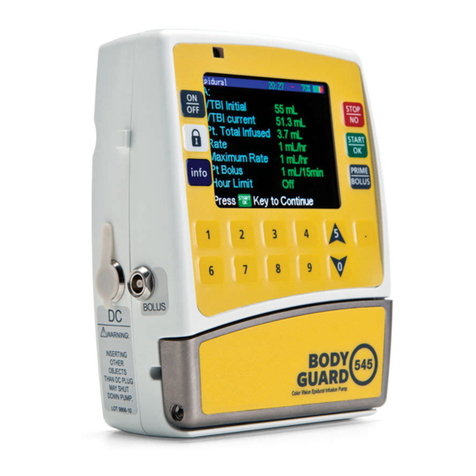
CME Medical
CME Medical Bodyguard 545 Instruction manual
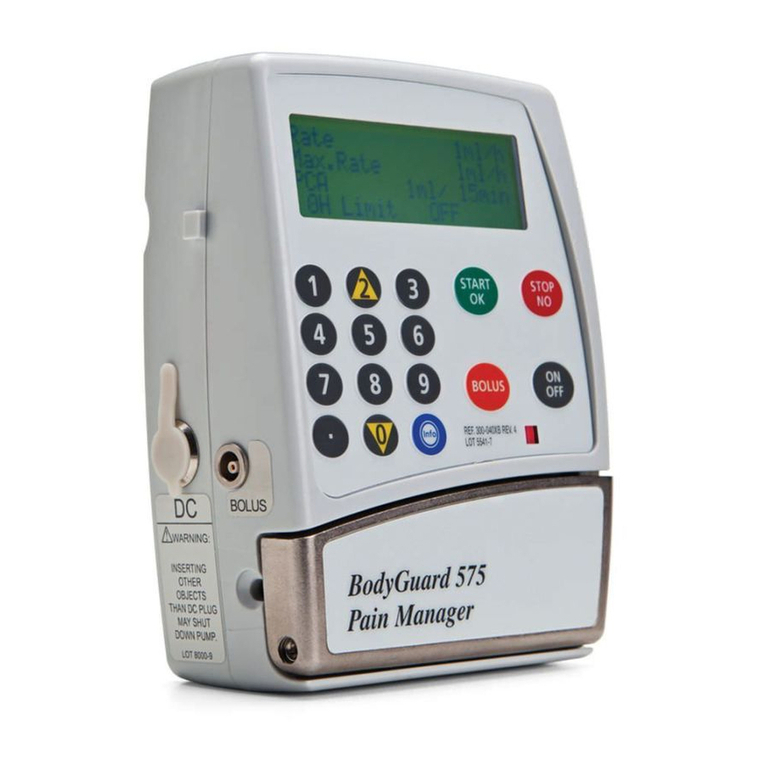
CME Medical
CME Medical BodyGuard 323 Instruction manual
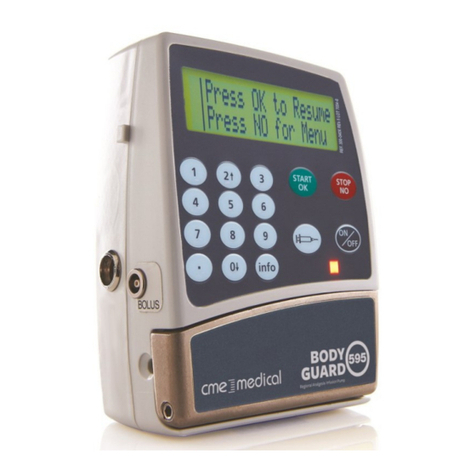
CME Medical
CME Medical BodyGuard 595 User manual
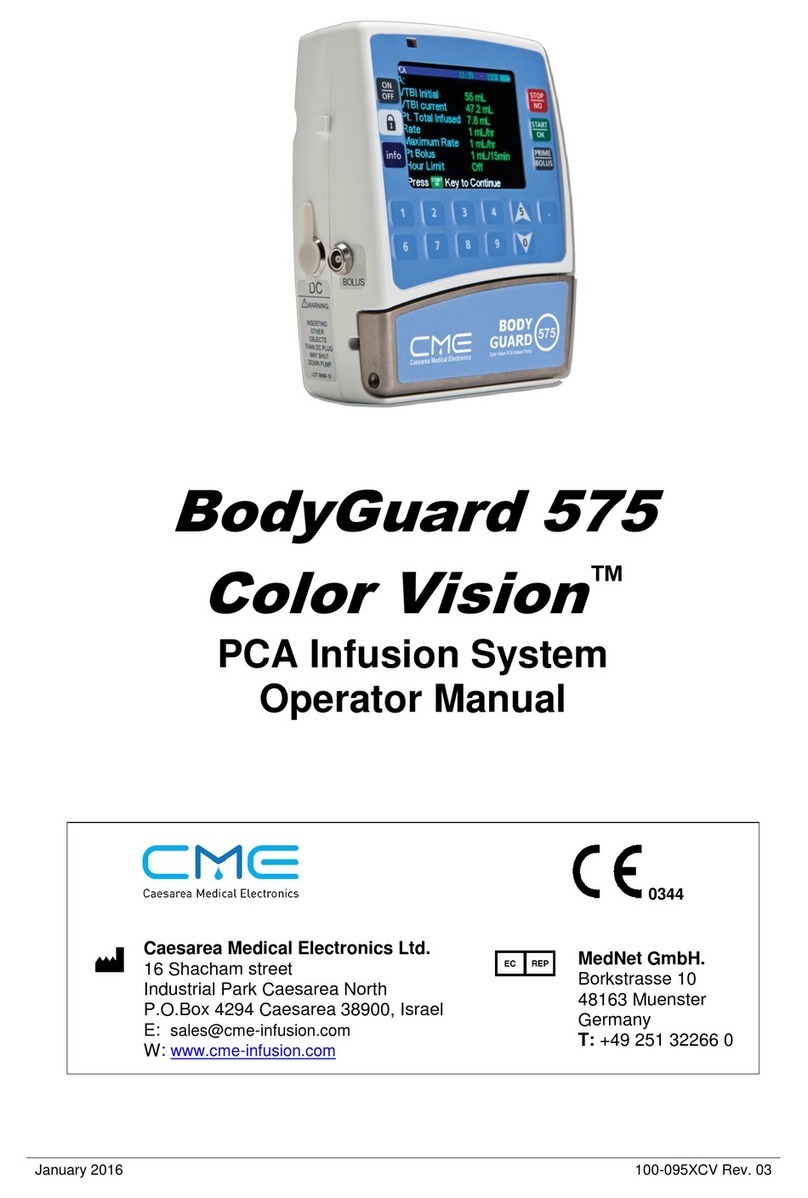
CME Medical
CME Medical Color Vision BodyGuard 575 User manual
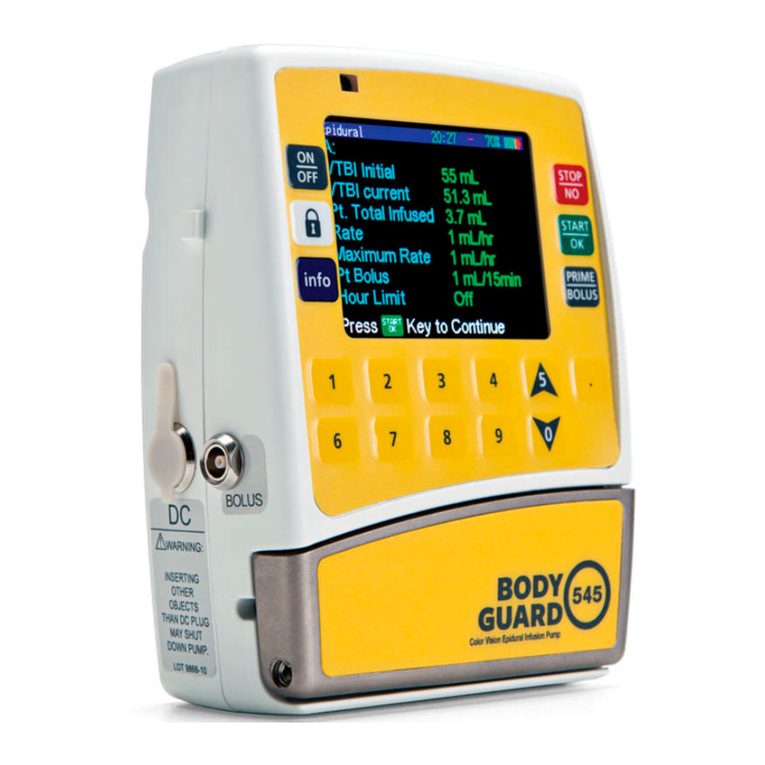
CME Medical
CME Medical BODY GUARD 545 User manual
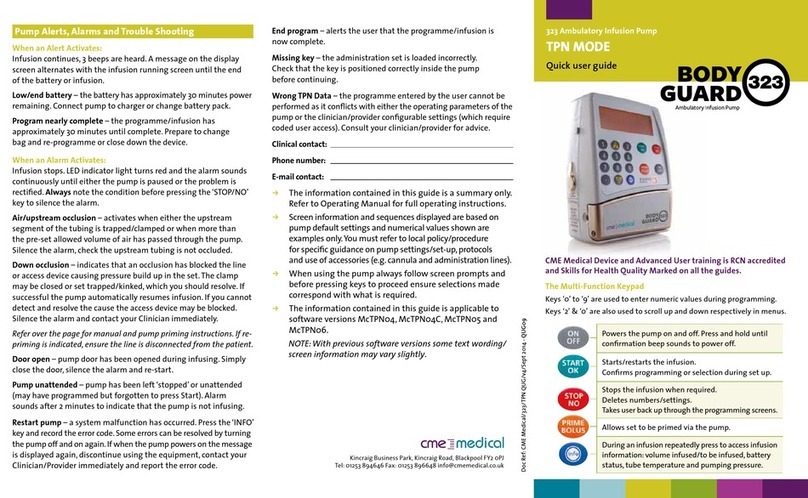
CME Medical
CME Medical Body Guard 323 Instruction manual
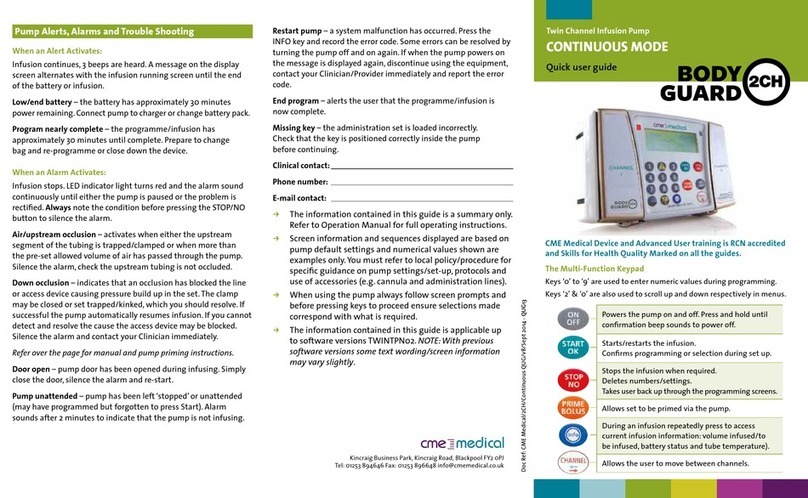
CME Medical
CME Medical BODY GUARD 2CH CONTINUOUS MODE Instruction manual
